An ode to the bar at the edge of the world..... page 20





by Oscar Fock
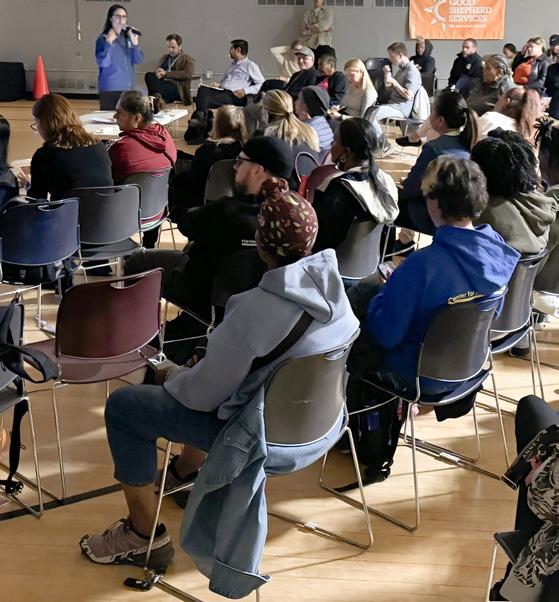
At the beginning of October, National Grid, the energy company primarily responsible for cleaning up the Gowanus Canal and the former Citizens Manufactured Gas Plant site (also known as Public Place), filed a lawsuit against 40 defendants, claiming they’re not doing their part to clean up the canal.

WITH
15
by Bob Racioppo
A BOOMER-TO-BOOMER
DIALOGUE with JOE FORD
After several columns talking with millennials I’m switching it up this month and talking with a fellow boomer Joe Ford. Joe is a recording engineer and music producer, and full disclosure I grew up with him in Sunset Park Brooklyn. This change is sparked by a comment in a previous column describing boomers as “too
Following the news of the lawsuit, concerns arose among community members that the latest litigation would further delay the remediation of Public Place, which, once the cleanup is complete, will be the home of “Gowanus Green,” a development of 955 affordable housing units, a school, a playground and a public park. The cleanup was already delayed earlier this year, when the New York State Department of Environmental Conservation (DEC) told National Grid that the current remediation plan was inadequate to satisfy new Environmental Protection Agency (EPA) guidelines. In response, National Grid started a dispute resolution process, which they have the right to under its agreement with the state. At some point this year, this formal process was put on hold, and ne-
old to matter.” We are sitting having coffee.
B.R.- Joe, the first question I always ask is, DO YOU WALK WITH COFFEE?, which is the trend these days.
Joe -The short answer is NO. I like to grind my coffee every morning, then I make a pot. I change my coffee every day , switching between 8 O’clock medium blend….”
B.R.- “A&P?”
Joe Ford- Yes , “A&P”, whole bean Columbian or French roast. I like to change my coffee up and I like to sit and drink it.
B.R.- But you’ve noticed people are
"Public Place remains the most polluted spot along the Gowanus Canal and one of the most polluted places in the state. And no one seems to know — or be willing to share — when that will change."
gotiations have now been going on for some time between DEC and National Grid to iron out what the cleanup plan will look like. According to Brian Carr, lead EPA attorney for the Gowanus Superfund site, who spoke recently at a Gowanus Community Advisor Group (CAG) meeting, the new remediation plan will meet — and may even exceed — EPA requirements, but nothing has so far been shared with the public.
National Grid’s lawsuit will likely not delay work at Public Place, as it is a separate project from the Gowanus Canal Superfund cleanup. Still, as negotiations between National Grid and
walking with it.
Joe Ford- Yes people are walking with coffee, people are eating dinner in their cars, people are on their phones when strolling with their child who is looking up and being ignored. We are multi-tasking everything and not getting the full experience of anything.
B.R.- Millennials tell me they walk with coffee because it’s just part of the flow. You get 2 things done at once. It’s production, production, like being part of the machine..
Joe Ford- “If you sit with a good cup of coffee the caffeine has the effect of energizing and relaxing you at the
DEC drag out, Public Place remains the most polluted spot along the Gowanus Canal and one of the most polluted places in the state. And no one seems to know — or be willing to share — when that will change.
The state’s environmental conservation department wrote in an email that the agency doesn’t anticipate that the lawsuit will affect the cleanup of Public Place, but did not provide further details on the timeline for the site or what the remediation plan will look like. Quoting from the email:
"New York State has a proven track record of successfully investigating and cleaning up many contaminated sites across New York State, including former industrial sites along the Gowanus Canal, as part of DEC’s ongoing mission to protect public health and the environment. DEC will ensure that the BCP applicants implement a cleanup that is fully protective of public health and the environment. DEC works closely with New York State Department of Health (DOH) and the U.S. Environmental Protection Agency (EPA), as appropriate, to ensure clean-
(continued on page 10)

same time. It’s
481 Van Brunt Street, 11AR
Brooklyn, NY 11231 (917) 652-9128
www.star-revue.com gbrook8344@gmail.com
Editor & PublishEr
George Fiala
rEPortErs Nathan Weiser
Brian Abate
Oscar Fock
Katherine Rivard
FEaturEs Kelsey Sobel
inquirEr Lisa Gitlin
CulturE Roderick Thomas
ovErsEas man Dario Muccilli
insights Joe Enright
musiC Kurt Gottschalk
Jazz George Grella
Film Dante A. Ciampaglia
books Michael Quinn
Cartoons Marc Jackson
Sophie Furman
WEbmastEr Tariq Manon
CraFts Marie & Sage Hueston
dEsign George Fiala
Merry Band of Contributors
Ranaan Geberer
Howard Graubard
Nino Pantano
R.J. Cirillo
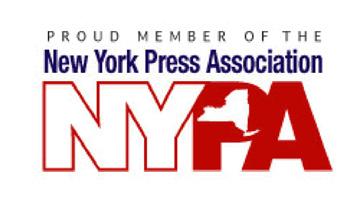

FOR EDITORIAL, ADVERTISING OR EMPLOYMENT INQUIRIES, email gbrook@pipeline.com
The Red Hook Star-Revue is published every month.
Founded June 2010 by George Fiala and Frank Galeano
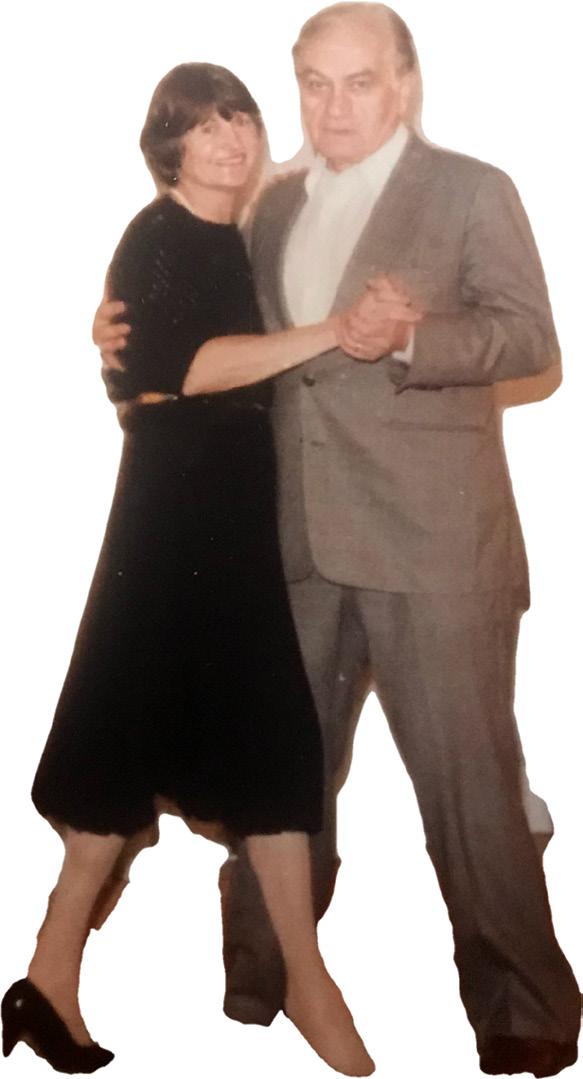
by Katherine Rivard
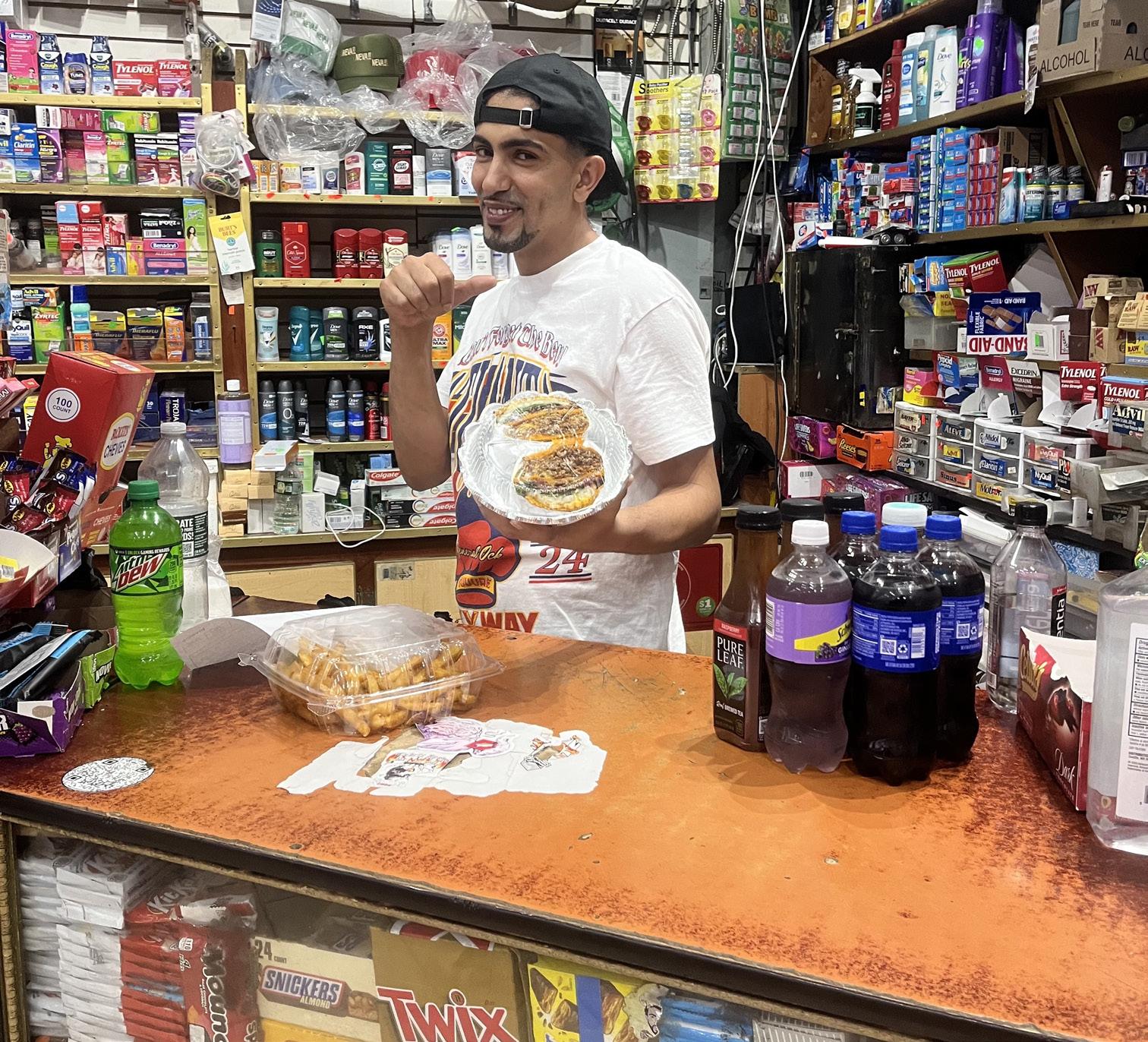
Achopped cheese, bread swapped for a Jamaican beef patty. Bacon egg and cheese, but coddled between raspberry PopTarts instead of a roll. Halal chicken with Salsalito turkey and spicy Doritos, all sandwiched between pancakes. Ingenuity is alive at the TikTokfamous Red Hook Food Corp (603 Clinton Street), where Rahim Mohamed has grown a following for his wild off-menu creations. Despite four years of internet fame, the business still has a pinned up banner rather than a permanent sign, but everyone knows exactly what it is. Mohamed does not own the store, but as he puts it, he is CEO of the “Ocky Way”—the tagline he uses as he cooks up the specialty sandwiches (“Ock” is a shortened, phonetic version of “akh,” which means “brother” in Arabic). He is the main attraction for 976,000 Instagram followers and over 5.4 million TikTok followers who want to see his
wild sandwiches and the people who order them. Although he has worked in the bodega for years (it was previously at another location), he started the social media account during the
"Mohamed remains eminently approachable, with a brotherly camaraderie he extends to everyone who stops in."
pandemic. Now, tourists travel from across the boroughs and the country to try his creations. Even celebrities make the trek, with notable visits from rappers like Big Sean and Lil Uzi Vert,
and athletes like NFL player Eli Manning and NBA player Mikal Bridges. Recently Ocky and his partners deceded to expansion into the 99 cent store they also owned next door. Enlargement of the small bodega has already begun, and Mohamed estimates that the project will be completed in about two months. It will allow the store to provide a greater variety of foods to customers. He is also planning a grand opening, complete with a rapper-studded guest list and perhaps even Mayor Adams (depending on the status of his lawsuits).
Despite internet fame, Mohamed remains eminently approachable, with a brotherly camaraderie he extends to everyone who stops in. On a recent evening, Mohamed happily answered my questions while simultaneously manning the cash register, a wide grin always on his face. As I left the store, he called out: “Have a blessed day!” That’s the ocky way.

Yeah, that's from the old Crosby Stills and Nash song. It's kind of all I could think as I started focusing on what to write here.
Originally I was going to talk about how impressed I was going on the Brooklyn Marine Terminal media tour—I really now believe that they are serious about the future of our containerport—but it's a couple of days after the election and all I can think about is how I felt in 2016. So lets dip into the archives and see what your neighborhood paper wrote back then:
Dateline November 2016: Red Hook’s streets were quiet Wednesday morning, with the few pedestrians walking their dogs or waiting for the bus looking despondent.
“It’s unsettling and confusing and I’m not really sure what’s going to happen next,” noted a man on King Street.
“I think it’s embarrassing,” said a woman near Wolcott. “This is what happens when people don’t go vote. I’ve been thinking about it all morning – I don’t know what it means I just know I don’t like it.”
Employees at several businesses were in tears and did not want to comment.
Donald Trump will be President of the United States come January, which means that the businessman and reality television star will assume leadership of a wide variety of important federal agencies and departments.
As a diverse coastal community, Red Hook is impacted by a wide array of these agencies, from the Depart-
ment of Housing and Urban Development (which funds the Red Hook Houses) to the Environmental Protection Agency to the Department of Homeland Security, which manages the U.S. Citizenship and Immigration Services.
Due to Trump’s political heedlessness and inexperience, it is hard to predict how Red Hook will be impacted by his presidency. His policy positions are unclear, and his efficacy as President is uncertain. But what impact might President Trump have on our neighborhood?
Border control and deportation of undocumented immigrants was, in many ways, the centerpiece of Donald Trump’s campaign. In September he promised to target between 5 and 6.5 million undocumented immigrants for immediate deportation and to triple the number of Immigration and Customs Enforcement (ICE) officials. In total, his plan would cost between $51.2 and $66.9 billion dollars over the next five years, according to the Washington Post New York City has an estimated 500,000 undocumented immigrants, and some of them attend Summit Academy Charter School.
“We serve a migrant community, and many of our scholars and their families are in this country without citizenship,” says Natasha Campbell, founder and executive director of Summit Academy. “And [Wednesday], in light of Donald Trump being elected President, we had kids who were concerned that almost immediately they or their families would
be deported.”
Summit Academy staff is working to provide students an outlet for their concerns, holding multiple assemblies Thursdays where scholars can voice their fears and ask questions. “In the coming days, they’re going to all write letters to Mr. Trump, to talk about what they’d like to see happen in his four years as our leader,” says Campbell. “I don’t know, we’ll see. We have to explain to our kids that it’s not that simple, that Donald Trump doesn’t wake up tomorrow and deport everyone that doesn’t have citizenship.”
Tim Vetter is Summit’s High School Assistant Principal. “We had a graduate last year whose parents were illegal immigrants, who shared stories with us about working with their parents on days off, who needed the money. We have a number of kids whose parents are undocumented,” says Vetter. “It could have a drastic impact. The impact that we’re already seeing, the reason we’re having this assembly today, is that people are just freaking out. People are upset, I don’t know what’s going to happen.”
Vetter also has concerns about Trump’s impact on the Department of Education, which the PresidentElect has indicated he would like to close entirely or at least drastically scale back in favor of local control and school vouchers. Although Vetter works at a charter school, he says different students have different needs.
“In this neighborhood, there was a need for [a charter school]. But I’ve worked in public schools, I’ve seen
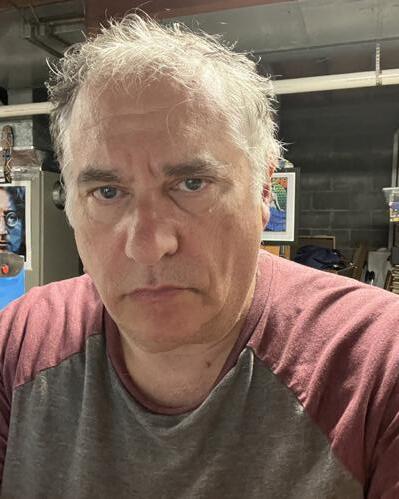
teachers in public schools who work incredibly hard,” says Vetter. “It’s tough. It’s tough in New York City, it’s tough in a neighborhood that needs help, and we need to look at it more as a community issue than as a school issue or a public versus charter issue.”
“For me, it’s too soon to speculate as to what it will mean for the community,” says Bea Byrd, who serves on the boards of the New York Public Housing Authority and the Addabbo Family Health Center. “I think we’re all in shock.”
“I’m not a doom and gloom kind of person,” says Byrd. “Let’s give him an opportunity to stand up and be the man that he alleged that he was going to be for all of the people, and let’s see where it goes from there.”
Byrd was excited by the long lines of people waiting to vote in Red Hook, but she cautions against complacency. “You have to care every day, you have to be vigilant every day, if affordable health care is under attack, we have to fight back. You can’t just lay down and roll over because there’s a different person in the White House,” says Byrd. “All those people who stood in long lines and who voted, stay on the lines! Stay out there! Stay vigilant in your community!”
“Whoever is in the White House will not make a difference in this community if the people in this community stay on their watch,” she added. Back to me: It's hard to believe we are back here again. Deja vu.But this is the country we live in. See you next month.

BY STAR-REVUE STAFF
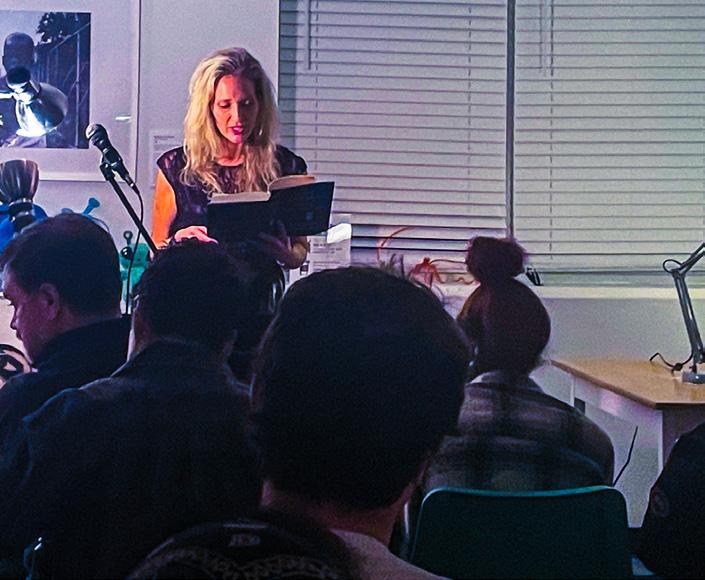
Interim library celebrates Halloween
The Red Hook Interim Library kicked off Halloween week with Thrillers & Chillers: A Reading Series on Oct. 29 in front of a packed crowd of 20 people. Authors included Melissa Lozada-Oliva, Kimberly McCreight, Melody Bates, Erin E. Adams, and Lauren Wilkinson and themes included mystical mothers and daughters, Cold War spies, bloody disappearances, and evil forests. All of the readers did an excellent job and there were also delicious treats and drinks.
Upcoming events at the Red Hook Library include Resume and Cover Letter
Assistance on Nov. 4 and Nov. 18 from 2-3 pm, Ezra Jack Keats Story and Craft on Nov. 4 and Nov. 18 from 3:30-4:30 pm, Comic Book Drawing Class with Mr. Nick, every Tuesday in November from 3-4:30 pm, Word Wednesdays on Nov. 13 and Nov. 27 from 3:30-4:30 pm,
Read and Play on Nov. 5 from 11-11:45 am, Teen Time DIY on Nov. 6 and Nov. 20 from 3-4 pm, Kids Create on Nov. 7 from 4-4:30 pm, Story and Play on Nov. 8, Nov. 15, and Nov. 22 from 11-11:30 am, and Felted-Bead Making Workshop on Nov. 21 from 3-4:30 pm.
Red Hook Town Hall
NYC Council Member Avilés and NYS Assembly Member Mitaynes are hosting a town hall to gather community feedback and concerns regarding the future of the Brooklyn Marine Terminal. The community wanted a space for open conversation, so CM Avilés and AM Mitaynes, both of whom serve on the Task Force, will come together to hear directly from residents. These community discussions will serve to better inform both electeds as they will represent community interests throughout the planning process. The event will be held at the Miccio Center on Tuesday, December 3 at 6:30. Flaco's death may bring aloft a new law
District 22 Council Member Tiffany Caban introduced legislation that could protect New York’s bird population while also creating union jobs.
“I am proud to have introduced legislation today which would require large buildings in New York City to retrofit their windows with bird-friendly materials,” Caban said. “Each year, a billion birds die in the United States alone due to collisions with buildings. New York City is not exempt from this crisis, with an estimated 250,000 birds dying needlessly each year within our city limits. This loss of life is a direct contributor to the biodiversity crisis our planet is experiencing.
“The recent death of Flaco, a Eurasian eagle-owl, has highlighted the urgent need to address the issue of breeding birds killed by window collisions in New York City. This bill aims to prevent such tragedies by requiring building owners to install bird-friendly window treatments by 2030. These critical building upgrades will create a substantial number of good union jobs for painters and glazers tasked with replacing existing windows.
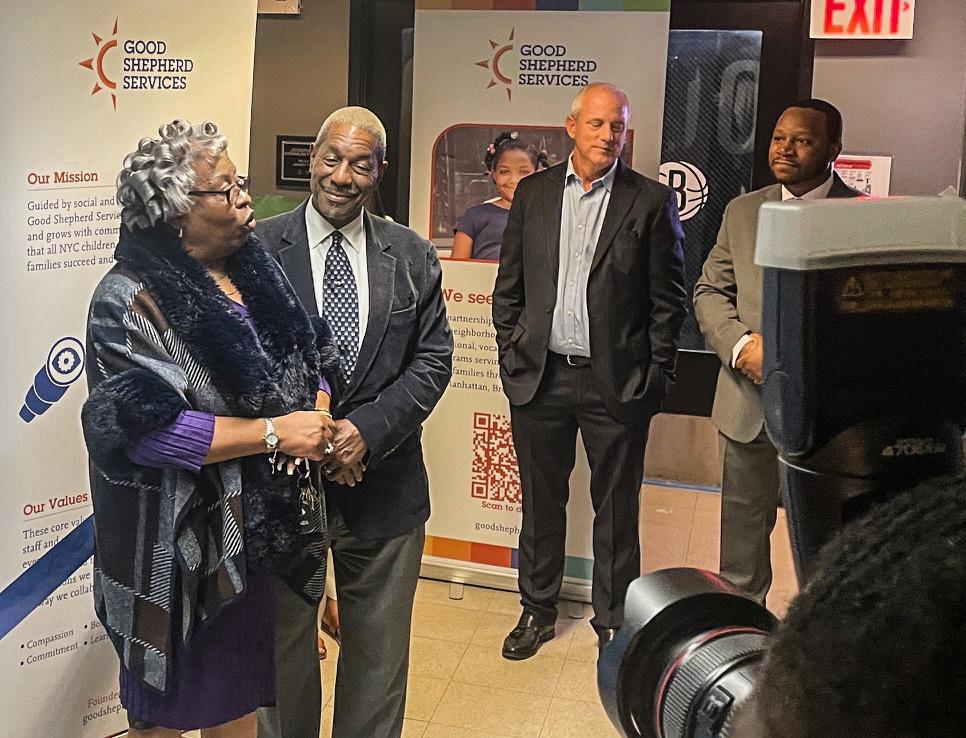
New learning center at Miccio Good Shepherd Services partnered with AT&T for the grand opening of a state-of-the-art Connected Learning Center (CLC) for kids and teens within the Miccio Center (110 W 9th St.) on Oct. 23. The CLC offers high-speed internet access, desktop computers, laptops and high-quality educational tools and programming to kids who encounter barriers to online participation.
Carroll Gardens library receives a grant
$230,000 in new funding has been obtained from the state by the Carroll Gardens library to modernize the elevator, upgrade the bathroom and water fountain. This was something the

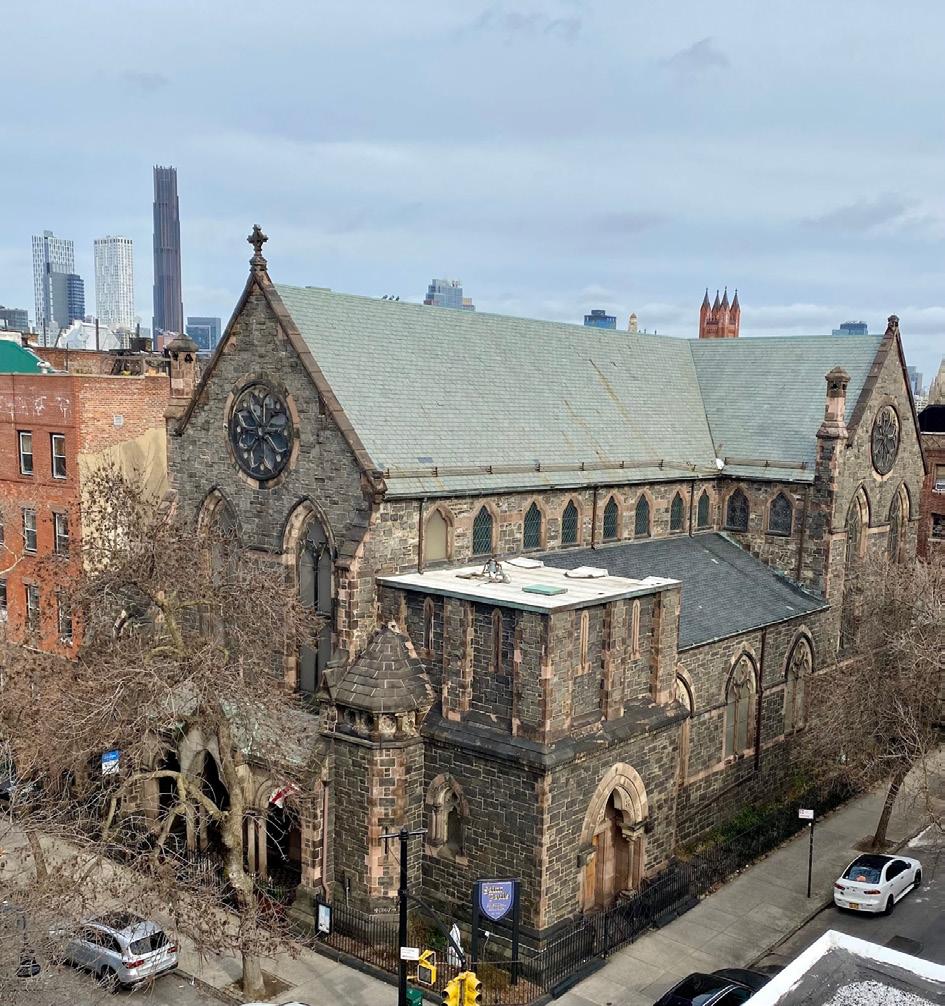

Carroll Gardens community has been asking for. The library will hopefully open towards the end of next year.
“Our Library is very important to our community,” said Ginger Gaines, President of the Friends of Carroll Gardens Library. “We are very grateful to Brooklyn Public Library for listening to our requests and finding the funding to make these long-needed repairs.”
St. Francis Honors Louis Valentino Jr.
St. Francis College is honoring Louis Valentino Jr. in its featured alumni series. He was born in 1958 and grew up in Red Hook. He attended Xaverian High School and then studied at St. Francis College, where he graduated summa cum laude in 1979. He became a firefighter in 1984 and in 1993 he became a member of Brooklyn’s elite Rescue Company 2. He also served as a lifeguard in Coney Island, working there for 18 summers.
On February 5, 1996, Valentino died of injuries sustained while searching for victims of a fire in Canarsie. During his distinguished career as a firefighter, he received two departmental citations for bravery. He was posthumously awarded the Fiorello H. LaGuardia Medal for Bravery and was added to the Roll of Honor by the National Fallen Firefighters Foundation. Valentino Pier Park in Red Hook is named after him, and a ballfield in Carroll Gardens is also named after him.
Valentino did not die in vain, and his life is an inspiration to students and alumni at his alma mater. He will not be forgotten at St. Francis College.
(continued on next page)
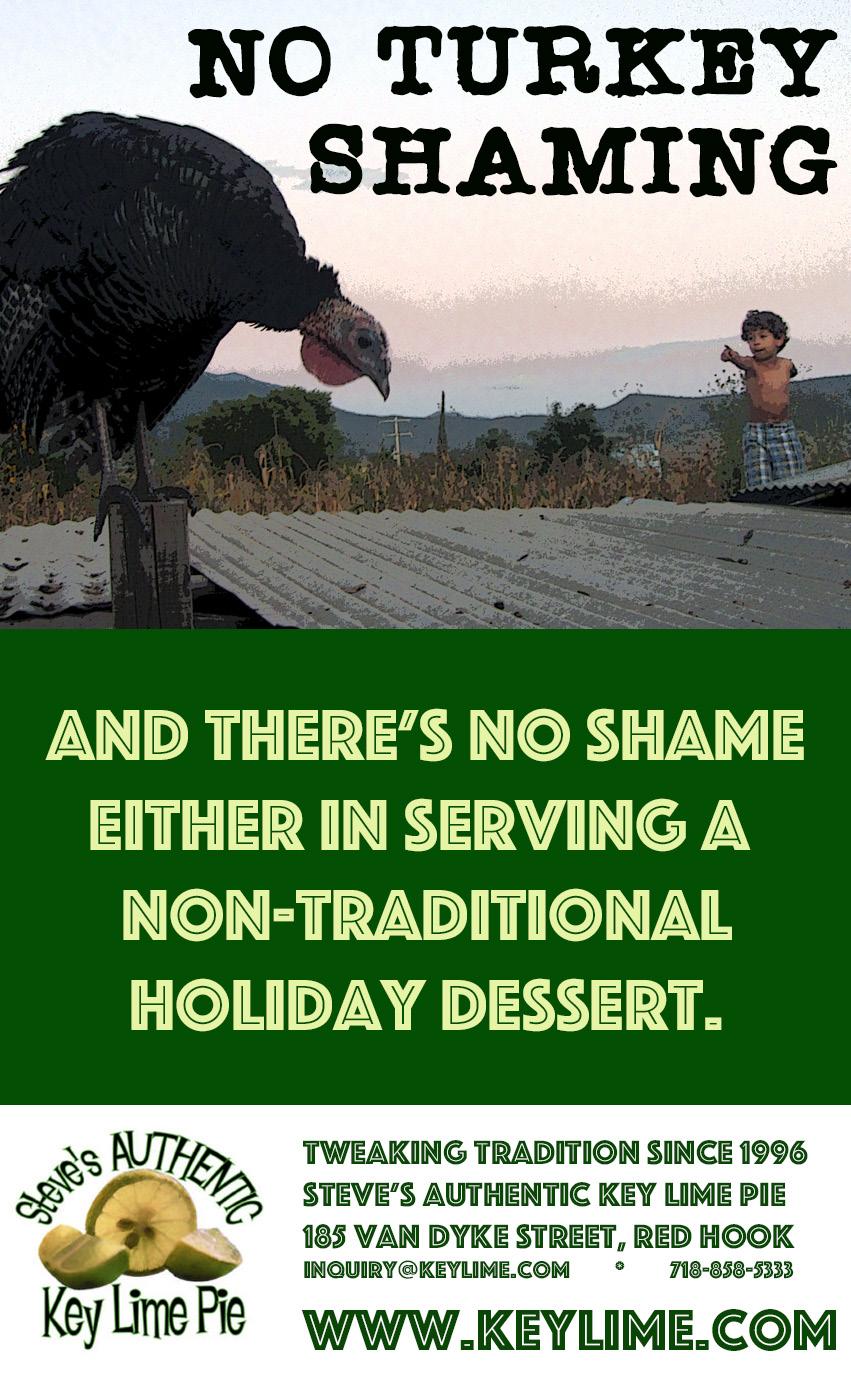
(continued from previous page)
With this new funding, Carroll Gardens Library can avoid a second lengthy closure. The new projects will begin after the current phase of work. The current phase, managed by the NYC Department of Design and Construction (DDC), includes a new heating and cooling system, historically appropriate lighting, and a teen center.
EDC extends deadline for the Vision Plan for Brooklyn Marine Terminal redevelopment
In an announcement on Thursday, Oct. 31, the New York City Economic Development Corporation (EDC) said that it has officially extended the deadline for the Brooklyn Marine Terminal Task Force to submit their master plan for what the new marine terminal should look like.
The decision comes after members of
the task force requested more time to properly investigate the various aspects of the project.
“We heard some of that feedback from the members of the task force and we’re responding. This is a incredibly comprehensive and deep community engagement process,” Andrew Kimball, CEO of EDC, told reporters during a media tour of the facilities at the Red Hook container terminal.
The quasi-government agency also announced that, due to public interest, two more public tours of the site will be held this November. Previously, two tours were scheduled for Nov. 7 and Nov. 8, and now two more dates — Nov. 11 and Nov. 14 — have been added. The tours begin at 9 a.m. at 90 Columbia St., and last for two hours.
Those interested in touring the Brooklyn Marine Terminal must reserve a spot in advance. EDC will also continue to hold public feedback session in November. To reserve a spot for either the tour or the public feedback session, visit EDC’s webpage for the project, edc.nyc/project/brooklynmarine-terminal.
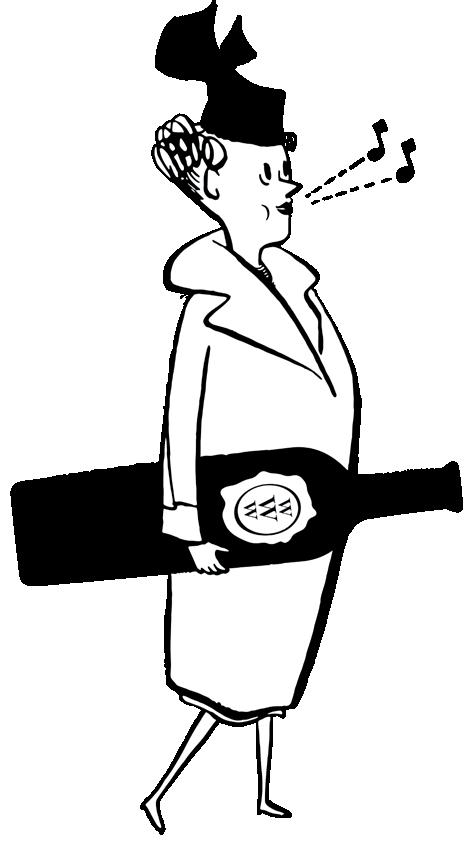
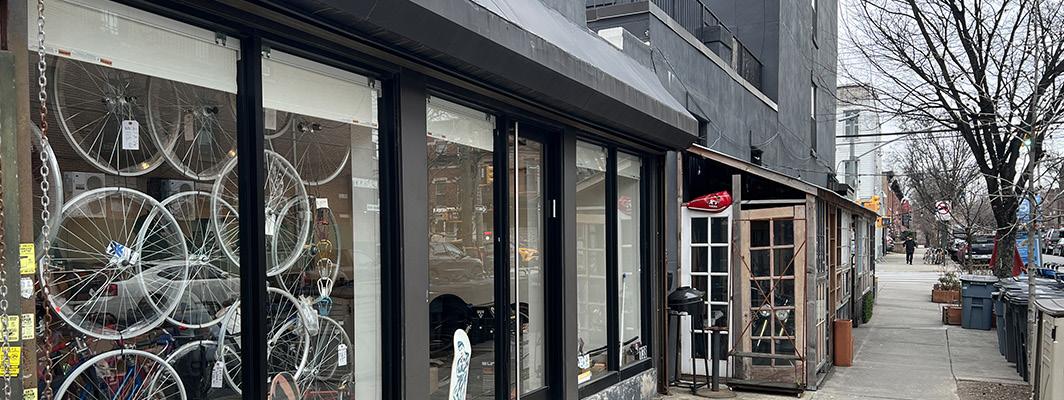

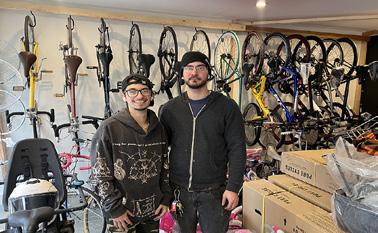

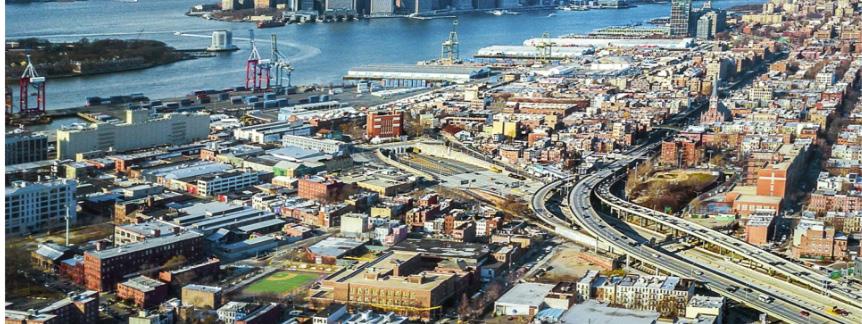


by Brian Abate
There have been a few large community meetings and some smaller ones following Mayor Adams’ May 14 announcement about a planned transformation of the local waterfront. This has been the plan of the NYC Economic Development Corporation (EDC) who is tasked with leading the transformation.
I attended one of the smaller sessions on October 23. Four people showed up to listen to EDC's Annelies De Jong and Chris Rice of WXY Studio. WXY is an architectural consultant whose clients include numerous city agencies. EDC has picked them to lead their outreach efforts.
“We are working on the project in a couple of different ways,” Rice said. “We’re leading the planning and engagement so we’re organizing the public workshops and surveys. We make all of the materials to engage people and our work is to synthesize everything we’re hearing and make sure that that’s getting fed into the
Master Plan and any proposals or designs that come out of this project.”
Both Rice and De Jong said that this project is still in the very early stages and that a big part of the project is listening to what people in the community think. In the bigger meetings, not everyone will have time to speak or ask questions which is why they believe the smaller feedback sessions are also important.
“Right now, it seems like a lot of people are concerned about housing and have said that they do not want tall buildings,” De Jong said. “People have been adamant about not compromising the view.”
At the Oct. 23 event, a few people said the same kinds of things. Housing has always been listed as part of the eventual plan, although EDC has rarely spoken about it publicly.
Another concern that evening was a lack of trust between some Red Hook residents and the EDC. Members of the EDC are trying to earn the trust of
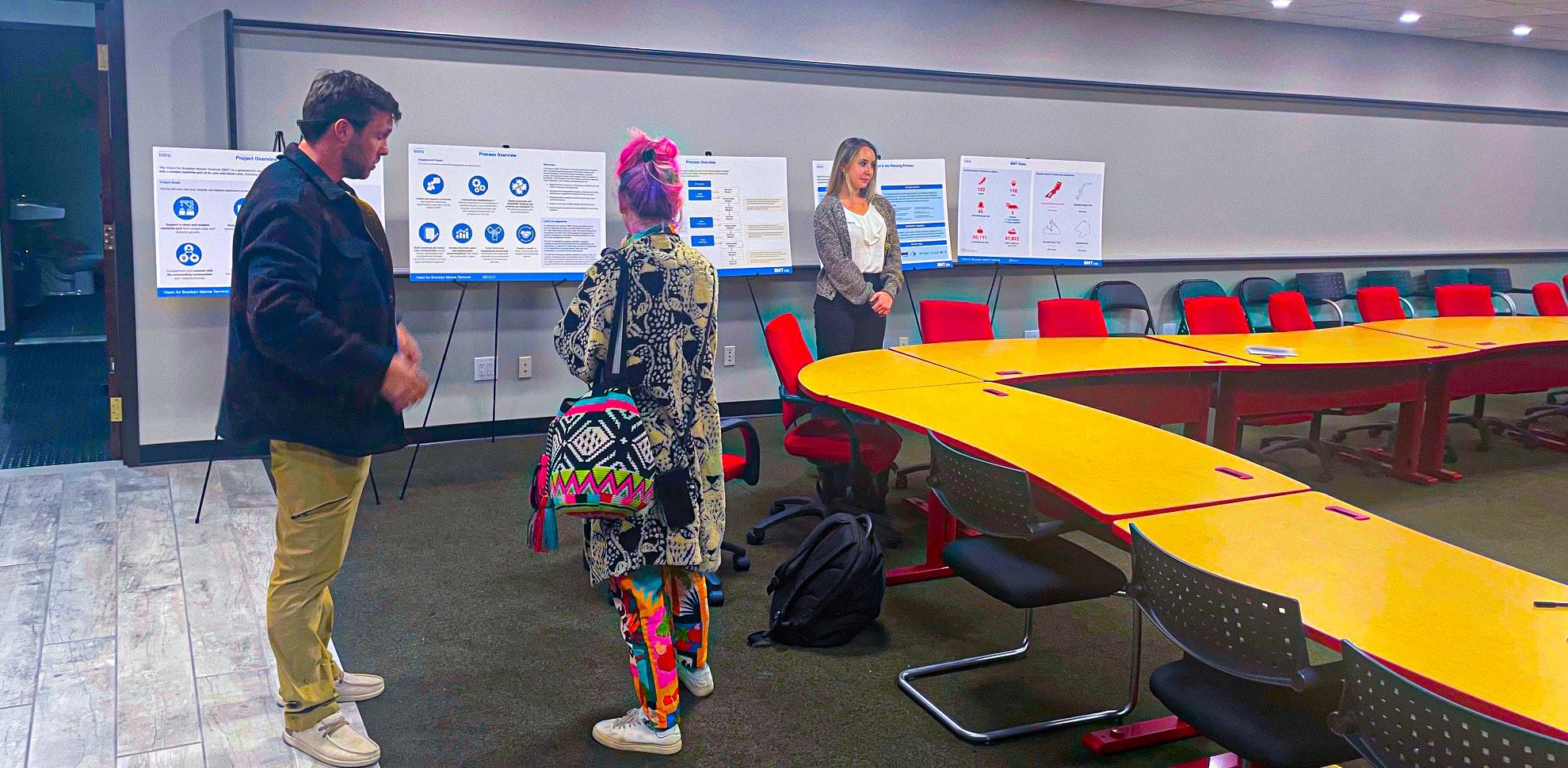
those in the area, including those who are skeptical, and they are hoping that having the feedback sessions will help.
“We want to make sure that community feedback is the foundation of what comes out of this process,” Rice said. “Some of the emerging topics that people have been interested in are public spaces, parks, and waterfront access. That has come up in the public workshops and it’s still very
early so I’m hesitant to say definitively that that’s what people want, but it has come up in conversations.
Four people is not a lot of people to influence. But it's a start. There will be more meetings as well as actual tours of the site. You can register for tours at the BMT website (just google Brooklyn Marine Terminal).
by Oscar Fock
Imagine a box of bananas. For days, it has traveled from South America over the Atlantic Ocean and now it has arrived at Pier 10 of the Brooklyn Marine Terminal (BMT). What happens next? It doesn’t go directly into the city — to restaurants or grocery stores — but the bananas can’t stay at the marine terminal because there is no cold storage there. Instead, the fruits are put on a barge headed for New Jersey, where there is appropriate storage. Eventually, the bananas are sent back to New York, to Hunts Point, via truck. Once there, another truck picks up the bananas to drive them to their final destinations. This is the case for many groceries arriving daily at the Brooklyn Marine Terminal. Because of a lack of infrastructure, New York City still relies heavily on trucks to bring goods into the city.
“That’s nuts,” said Andrew Kimball, CEO of New York City’s Economic Development Corporation (EDC), in front of a small group of reporters who had braved the cold and wind that morning. “In the future, it should come in here and get into cold storage. It should go directly out to the final destination by E-cargo bike or electric truck, or it should get on a barge and go directly up to Hunts Point and land there, get processed and distributed within the city.”
This is, in essence, the plan for the mas-
sive overhaul of the Brooklyn Marine Terminal, according to Kimball, whose organization — which, while not a city agency, serves as the city’s official economic development organization — is leading the project.
On Friday, Oct. 25, EDC held a press tour of the terminal, sharing more details about the plans for the project and allowed members of the media a look at parts of the BMT that are usually off-limits to the public.
Currently, a task force of 28 members is working to put together a master plan for the 122-acre site, which will serve as the guiding document for the rest of the project.
Since the BMT redevelopment was announced earlier this year, many community members have expressed concern that remaking the marine terminal would mean lining the Columbia Street Waterfront District and Red Hook waterfront with luxury high-rises. But there will probably be housing somewhere, according to Kimball and two people involved in the task force’s work, it is far from the focal point.
“It’s very much about what this site should look like in the future. How can we expand the footprint of maritime here? Get more containers in and out, make this a key node on the blue highway. Where can we use some of the sites today that have nothing to do with maritime for other important
community uses, like housing or green space?” Kimball said, adding that everything has to fit together while also relieving pressure on the streets in the neighborhood.
The “Blue Highways” initiative is a City-led effort to shift freight from the
“What we’re working on today is an opportunity to reimagine freight mobility in New York City for the next 50 years.”
streets to the city’s waterways. It is not an idea sprung out of the redevelopment of the Brooklyn Marine Terminal, but once the project is finished, it will serve as a key node in the blue highway system.
“What we’re working on today is an opportunity to reimagine freight mobility in New York City for the next 50 years,” explained Michael Stamatis, CEO of Red Hook Terminals, which has leased part of the terminal for years. “That means modernizing the facilities, bringing in new kinds of equipment,
replacing old infrastructure with new, modern infrastructure, and building a supply chain system where cargo that is going to be distributed in the city can come into the city without ever having to go to a warehouse somewhere else.” Millions of pounds of fresh produce, seafood and other foodstuffs come into the Red Hook Container Terminal every week, he said, but much of it has to be shipped or driven out of the city to storage before it can return, due to the lack of final mile distribution infrastructure.
Today, operations at the Red Hook Container Terminal take about 30,000 trucks off the road every year. That number can grow substantially, argued Stamatis and Kimball.
“It’s just a question of what we want to accomplish. What resources are we going to dedicate to it? Think about the hundreds of thousands of trucks that are coming into the city. This is an opportunity to take a chunk of that and expand on what we’re already doing and increase it,” said Stamatis, who also chairs one of the BMT Task Force’s advisory groups.
Kimball did not have an answer for exactly how much of a dent the upgrades to the terminal would make to the roughly 120,000 trucks that enter the city every day. “But it is going to be substantial, and every 1% you cut into
(continued on page 12)
Red Hook Soccer Field 1, the easternmost recreational field of Red Hook Park, is finally getting cleaned up. According to Chris Clark, spokesperson for the New York City Department of Parks and Recreation, a work order was issued on October 28 for the reconstruction of the soccer field.
Reconstruction of Soccer Field 1 is one of the remaining projects in the Red Hook Recreational Area remediation, which also includes soccer fields 1-6 and ball fields 1-9. In 2022, the parks department and the Environmental Protection Agency (EPA) announced the completion of the remediation of ball fields 5-8, a part of the Red Hook Park that previously had been the site of a secondary lead smelting plant called Columbia Smelting and Refining Works. The reconstruction of soccer fields 3-5 and ball fields 1-4 is ongoing; according to the parks department’s website, the project is about 55% complete and will be finished in November this year, barring setbacks. (Originally the date was announced for January 2023).
“The health and safety of our parkgoers remain our top priority, and we are investing over $60 million to improve the Red Hook Recreation Area, righting a historic wrong and ensuring Red Hook residents have access to high-quality greenspaces for play and relaxation,” Clark wrote in an email. He added that the parks department is responsible for remediating Soccer Field 1. However, several questions remain about soccer field 1 and the tree-covered area surrounding it. And they begin just south of the field.
There, on 688-700 Court Street sits a parking lot and a few businesses. That site used to house a variety of manufacturing processes, including the production of metallic-organic soaps and salts, as well as plasticizers. During manufacturing, chemicals, including PCB-containing oil from a hot oil system, were released into the ground. Polychlorinated Biphenyls, or PCBs, are a group of man-made organic chemicals that have been banned in the U.S. since 1979. A robust body of research connects PCBs to cancer in both humans and animals, as well as a host of other adverse health effects. (Significantly elevated levels of lead, cadmium, barium, naphthalene, carcinogenic Polycyclic Aromatic Hydrocarbons and benzene have also been detected at and around the site, either in the soil or groundwater.)
The site is now an Inactive Hazardous Waste Disposal Site, declared such by the New York State Department of Environmental Conservation (DEC). In May 2002, the agency entered into an order of consent with Crompton
by Oscar Fock
Corporation, the then-owner of the facility responsible for the contamination, to investigate and remediate the site. After Crompton merged with Great Lakes Chemical Corporation to become Chemtura, Chemtura instead became the party responsible for cleaning up 688-700 Court Street.
Since then, nearly two dozen investigations have been conducted to establish where there is contamination and who is responsible for it. 2007 sampling showed PCB levels far beyond acceptable limits, reaching 450 mg/kg at the site of “building 14” on the northwestern part of the site, which housed the hot oil system. A report from 2009 titled “PCB Investigation Final Report” made on behalf of Chemtura, showed elevated levels of PCBs at the northeast quarter of the site, and a rendering of the spread of PCBs from the hot oil system showed how it had moved from building 14 past the northern border of the site, into Red Hook Park.
In April 2013, Chemtura submitted a Remedial Investigation Report, building upon a 2011 soil and groundwater investigation, partly into PCB contamination in the southern part of Soccer Field 1 in Red Hook Park. The report showed unacceptable levels of the toxic substance in the park but concluded that no PCB contamination beyond 20 feet into the park was the responsibility of the chemical company.
Initially, the environmental conservation department accepted the report, but in a letter dated March 10, 2017, the agency withdrew its acceptance due to the data gaps in the remedial investigation and instead asked for a Supplemental Remedial Investigation to be conducted.
Correspondence between 2016 and 2017 between the two parties highlights several disagreements. In September 2016, EDC officials sent a letter to Chemtura, stating that the agency views Chemtura as responsible for remediating cadmium found in the area around Soccer Field 1. (Cadmium is highly toxic and known to cause cancer, according to the Occupational Safety and Health Administration.)
In a response later that year, Chemtura attempts to shift blame for the cadmium contamination to either historic fill or to the lead smelting plant, which contaminated four of the nearby ball fields. In its March 10 letter, the state agency explains that a forensic analysis by EPA concluded that the cadmium in Soccer Field 1 likely is not smelter-related. DEC added that the highest levels of cadmium were found about 200 feet downwind of Chemtura’s permitted cadmium air emission point. “Chemtura’s asser-

tion that the cadmium in the park is the result of historic smelter operations is baseless and unverifiable,” the agency writes.
DEC and Chemtura also butt heads on whether Aroclor 1254 — a trade name for a kind of PCB mixture — was used on-site. DEC argues in its September 2016 letter that it indeed was used during manufacturing, but Chemtura disagrees in its response. Agency of-
“Chemtura’s assertion that the cadmium in the park is the result of historic smelter operations is baseless and unverifiable,”
ficials push back and notes that, perhaps, a lower reporting limit (the lowest concentration of a chemical that an analysis will accurately measure) would have showed the presence of other kinds of PCBs. The agency writes, “It’s notable that the sample locations with elevated Aroclor 1248 [another kind of PCB mix] concentrations, often had reporting limits well above standards, indicating the presence of other Aroclors may have been masked/under-reported.”
The state agency also requests a document, titled “ROW, WSP 2009.” DEC has still not received the document, DEC confirmed in an email.
The next publicly available document related to off-site contamination is from 2020, in the form of a work plan for further investigating the extent of chemicals and metals that have traveled from the site into the park.
The work plan, submitted to DEC by Lanxess, a German special chemicals company that in 2017 merged with Chemtura and overtook responsibility for the site, concludes that more work would be needed to delineate toxins like cadmium and PCBs. The report further declares that Aroclor 1254 is not a chemical of concern onor off-site.
Several key documents are missing from DEC’s public database, including the supplemental investigation report the agency requested in its March 2017 letter. According to the 2020 Remedial Investigation Work Plan, that report was submitted to the state in May 2017. There are also no documents available after 2020, except for an April 2021 consent order from DEC to MC PR III 688 Court Realty LLC, the property owner at the time. (Later that year, the property was acquired by real estate investment and operating company Madison Capital.)
According to Michael Mackin, corporate communications manager at Lanxess, the environmental conservation department accepted the work plans for the off-site remediation, as well as the 2022 Remedial Investigation Report that resulted from the work plans.
In an email, Mackin also wrote that the approved investigation report “attributes certain compounds to Chemtura’s historic operations, while others have been determined to be from non-Chemtura sources,” but did not share if Aroclor 1254 remained off the list of chemicals of concern.
DEC clarified in its email that the proposed remediation plan does not differentiate between different Aroclors, adding that Lanxess has agreed to clean up PCB contamination in the soil between the northern border of the 688-700 Court Street site and the southern sideline of the soccer field.
(continued on page 13)
Councilmember Alexa Aviles hosted a Town Hall last month to talk about construction at the Red Hook Houses.
“We have not had a meeting about all this construction in a long time,” Aviles said. “I thought it was going to be important that we have NYCHA come tonight and not only give you the update from their perspective but to also respond to your questions because you live here.”
Joy Sinderbrand, who manages NYCHA Capital Programs, led the discussion.
In December of 2015, after the devastation of Superstorm Sandy in 2012, NYCHA received access to the largest grant in FEMA history at the time, which totaled about $3.3 billion.
The work has included back up power generators, heat and hot water system, finishing the roof replacement work of every residential building, new carpets, basement flood proofing and temporary boilers in the buildings. The project’s many "lily pads" offers a landscape solution for flood protection. These are areas of refuge next to buildings so that when there is flooding people will have a place to come out of the building.
These lily pad areas have seating areas along with tables with checkers and chess boards. They are designed
by Nathan Weiser
PS
676
/ Harbor Middle School hosted Hispanic heritage family night on October 22 from 4-6 pm in the cafeteria. This was one of their many theme nights throughout the school year. There were many activities at the different tables, Spanish music to listen to and different Red Hook organizations at the event.
There was information on a table about Dia de los Muertos (Day of the Dead). Students could color in skulls (calavera) on pieces of paper.
The multi-day holiday involves family and friends gathering to pay respects and remember friends and family members who have died.
There was a table in the cafeteria where students and parents could design Day of the Dead themed marigolds using orange tissue paper and green pipe cleaners.
There was a wide range of drawings. One said everyone being different and emphasized diversity and another drawing was about disability awareness. The Future is Inclusive club talks about diversity issues and the money
by Nathan Weiser
to be specific to the buildings they are next to as the areas are different heights due to the flood risk of a particular building.
Sinderbrand spoke about trees, since that was a big concern of residents. Over 400 trees had to be removed prior to all the construction.
There will be a total of 481 new trees, which will be planted starting in the spring since planting season is over for this year. Half of the trees planted will be smaller trees, which are taller than a person.
“We want to give it the best chance of taking root and being healthy,” Sinderbrand said.
Many people have inquired about why there is so much fencing that has been up for a long time around the complex.
“The Department of Buildings would not let us take the fences down until local law repairs were done on the buildings as well,” Sinderbrand said.
“We had to make sure that all the facade repairs for the most recent local law cycle were done before we took the fences down.”
Ross Joy, manager of the housing resource center at the Red Hook Justice Center brought up concerns that the community has about the project.
“These past six years of this retrofit construction have been as bad if not worse of a disaster for our community
for the pictures went to the school.
On another table, there was information about the well known Mexican artist Frida Kahlo.
Kahlo is best known for her self-portraits that deal with themes like identity, the human body, religion, birth and death. She often wore flowers in her hair as a symbol of her Mexican heritage.
The range of information and activities continued with a Lee Quinones table. Quinones was born in Puerto Rico in 1960 and moved with his family to New York and grew up in the Lower East Side. He is considered one of the most influential artists to emerge from the NYC graffiti movement of the 1970s and 80s. He was famous for creating massive NYC subway car graffiti that carried his moniker LEE.
In the back where the food is normally served in the cafeteria, a few students were making the the arepa, which is a Colombian dish, from scratch throughout the event.
The arepa has fried cornmeal cakes on the outside and cheese on the inside. Sometimes there can be a meat or veggie filling.
Towards the end, there was yellow rice, chicken and plantains for everyone at that was sponsored by the school’s PTA.
Red Hook Art Project (RHAP) had two tables where the students had an opportunity to make an Affirmation Card using markers, pencils and paper.

than Sandy.”
“We are in year six of construction,” Joy added. “Why are the basements still not fixed. The incinerators do not work. What was missing from this presentation was when an end time is.”
He added that a presentation was given at the Justice Center last year that said the project would be done the end of this year and that is not happening. He asked for a date and time for when the construction would be complete.
Sindebard could not give a specific end date for the construction. She gave as an example that NYCHA digs up ground and finds unexpected things that need to be repaired.
They designed it with what they are inspired by, a quote they like or something meaningful to them. One had the quote “go everywhere, do everything” and another had a picture of a dog. They got creative with the cards.
There was a Red Hook community mural input survey that was distributed where they asked for feedback for their new exciting murals that they are going to do around the community.
“We have to secure the funding and make sure we repair before we close up the dirt,” Sinderbrand said. “That has happened multiple times in Red Hook.”
Vanessa McKnight talked about all of the increased scaffolding and the fact that she has not been able to open her windows because of the smell.
Sidebard said some improvements have to wait until planting season in the spring, which is why the project will not be finished until hopefully 2025. She added that their schedule was delayed due to the pandemic. They did not want to do water outages or some other types of work that would have disrupted when people were sheltering in place.
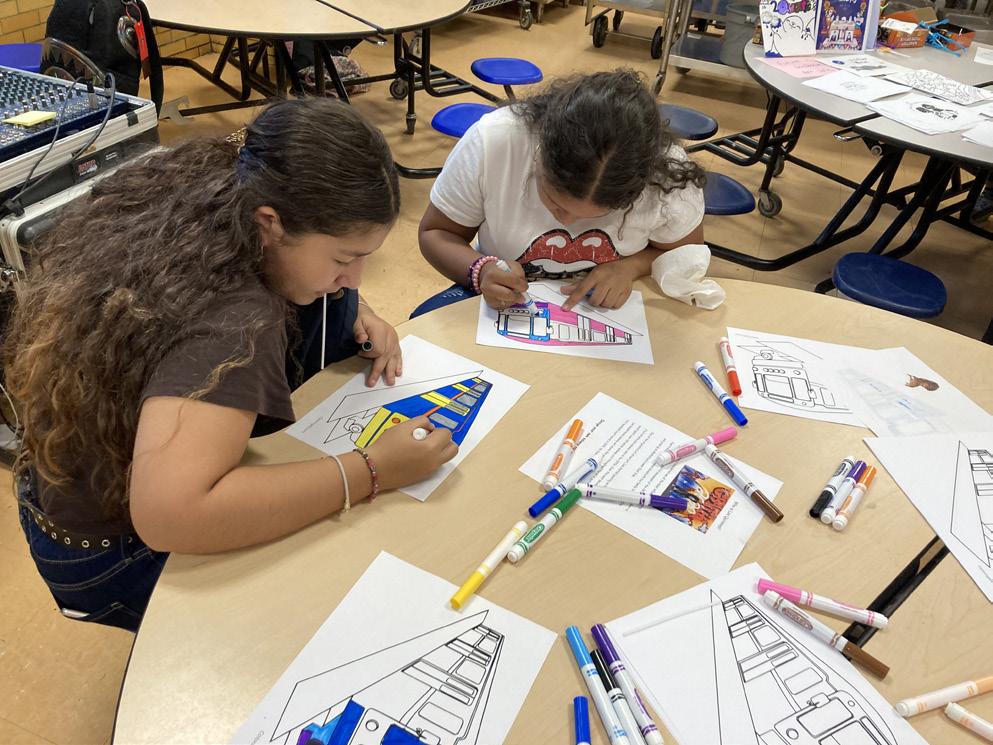
RHAP offers visual arts classes, film club classes, a digital media program, music classes, meditation classes, clay classes and public adult classes. Their school partners include PS 676, PS 15, Summit Academy and Pave Academy.
Pioneer Works had two tables at the event and had two iPads for the students to look at their art.
The had lots of materials for the students to get creative making puppets with supplies like markers, tacky glue, scissors and multicolor poms. Once they made the puppets, their was green paper on the wall as the green screen and then they could see their project on the iPad.
This Pioneer Works led project is designed for third-fifth graders and they have done this at other neighborhood schools.
Pioneer Works is an artist and scientist-led nonprofit cultural center in Red Hook that fosters innovative thinking through the visual and performing arts, technology, music and science.
The Red Hook Public Library had a table in the front. They had supplies and information about their teen day and their comic book drawing class with Mr. Nick.
They had information about their new temporary location at 362 Van Brunt Street between Sullivan and Wolcott. The hours of the temporary location are Monday-Friday 10 am - 5 pm. Support for programming and interim library services at this location while the main one is under construction was provided by Amazon. The 362 Van Brunt Street location has books, computers, WiFI, library cards and various programs.
by Katherine Rivard
In a time when the City’s Administration seems awash with scandals and resignations, few NYC bureaucrats have been as effective as Jessica Tisch, Commissioner of the NYC Department of Sanitation (DSNY). The citywide composting program, which requires all residents to compost their organic materials, is just one of several sweeping DSNY initiatives implemented during her tenure. The program was rolled out in Brooklyn and Queens in October 2023. As of last month, no matter which borough you live in, apple cores, dinosaur kale stems, and lemon rinds (or more realistically for many, coffee grounds, leftover chinese food, and stale bread) should be put into compost bins, not the trash. Fines for failing to compost organics will begin this spring.
According to DSNY, the agency is “thrilled to report that in the last two years, the amount of compostable material diverted from landfill has increased 23%, to an incredible 260 million pounds.” Looking at DSNY’s most recent monthly curbside collection report, in January 2024, Brooklyn alone diverted about 150,000 pounds of organic waste per day, compared to less than 63,000 pounds per day in each of the boroughs that did not yet have residential composting. Diverting organic material means that, rather than sitting in landfills where it releases methane into the atmosphere, organic materials can be turned into compost or biogas.
DSNY currently sends most of the organics it collects (about 80 percent) to a facility in Newton Creek in Greenpoint, where huge steel eggs (anaerobic digesters) convert the organics into a renewable fuel (biogas) that can be used to power homes. The remaining solids left over from this digestion
by Brian Abate
Residents of 63 Tiffany Place, neighbors, community members, and politicians all gathered for a rally outside of the 70-unit apartment building. There were about 100 people in total including all local city and state politicians, including even Shahana Hanif, who came over from Park Slope office. The building’s Low Income Housing Tax Credit (LIHTC) is expiring and that means all of the residents of 63 Tiffany are at risk of massive rent hikes that would force them out of their homes. Landlord Irving Langer
process create fertilizer. Skeptics were originally concerned that most of the organic material was being used to create biogas rather than compost, while the Adams Administration was simultaneously cutting funding for community composting programs. However, the resulting biogas that the organic material creates is used to heat homes and businesses, taking the place of fossil fuels that would otherwise be fracked to serve the same purpose. Last June, the City Council also restored funding of the community composting programs that had previously been cut from the City budget by the Adams Administration.
The remaining 20 percent of organic material collected via curbside composting is composted, and DSNY has entered into additional contracts that will drastically increase the number of districts whose material is sent to compost facilities, rather than to the digesters in Newtown Creek. Com-
"Few NYC bureaucrats have been as effective as Jessica Tisch, Commissioner of the NYC Department of Sanitation."
post facilities in New Jersey and Staten Island produce compost that is either given to residents or sold to landscapers. For the past few years, the compost facility on Staten Island has produced about 42 million pounds of finished compost annually.
Unfortunately despite these efforts, a significant portion of the Red Hook community (the residents at Red Hook East and West Houses) do not
bought the building in 2010. He has appeared on the Public Advocate’s Worst Landlord Watchlist due to cases of deferred maintenance, displacement of tenants, and deregulation of affordable housing.
“Langer paid $5.3 million for the building in 2010,” says community leader John Leyva, who has lived at 63 Tiffany for 30 years. “He has already made about three times that just in rent bills alone. He is going to make a ton of money either way, but he could do that without forcing us out of our homes.
“I have a 93-year-old neighbor, who served in the Korean War and survived brain cancer but he might not be able to survive this. Unfortunately, stories like 63 Tiffany are not uncommon.”
Politicians and local organizations like the Carroll Gardens Association have put pressure on Langer to reach an agreement that keeps the current tenants of the building in their homes

currently have a composting program on site. According to the New York City Housing Authority (NYCHA) who manages the properties, the agency’s goal is to provide all residents with access to organics collection by 2026. All NYCHA properties separate yard waste, and the agency is working with properties to retrofit mowers to mulch leaves in place, increasing efficiency and improving soil quality. A handful of other NYCHA developments throughout the five boroughs also have farm sites with composting programs operated by Green City Force and Compost Power. The closest opportunity for residents of Red Hook Houses to compost is at Red Hook Farms (560 Columbia Street). The farm accepts food scraps (no meat, dairy, or bones) 24/7 in brown bins located near the Farm’s gates at Columbia and Sigourney St. and at Beard and Otsego St. Their compost is used on the farm, and also given away monthly (follow their Instagram ac-
and there have been rallies outside of 63 Tiffany Place earlier this year and in 2023.
“We came to an agreement with Irving Langer and his associates through a memorandum of understanding and they were ready to meet the tenants with the parameters that the tenants outlined,” Hanif said. “Now I’m so disappointed that they just removed themselves from the agreement and are unfortunately not coming back to the table. My colleagues and I have sent a letter to him, saying that he must come back to the table and listen to the tenants’ demands. We await his response. We’re not just here to rally, I want folks to know that we’re taking the steps to get in front of Irving Langer.”
Many politicians and Leyva spoke about passing the Tenant Opportunity to Purchase Act (TOPA) and Community Opportunity to Purchase Act (COPA) as possible wider-scale solu-
count to stay up-to-date).
DSNY attributes the program significant use to the ease of the program, which does not require any sign up or even a specific bin. Although some supers and property managers have voiced opposition to the separate bins, which they believe are smelly and attract pests, all residential buildings are mandated to comply. For Brooklynites who have not begun separating their organic materials, brown bins can be ordered online from DSNY. Alternatively, any bin that holds 55 gallons or less and has a secure lid can be used in its stead, so long as a composting bin decal is attached (available online for free from DSNY). The bins are collected each recycling day. To cut down on clean up, the bins can even be lined with clear plastic, paper, or compostable bags. One final note: try to choose a bin made of a thick material; rats love your leftovers.
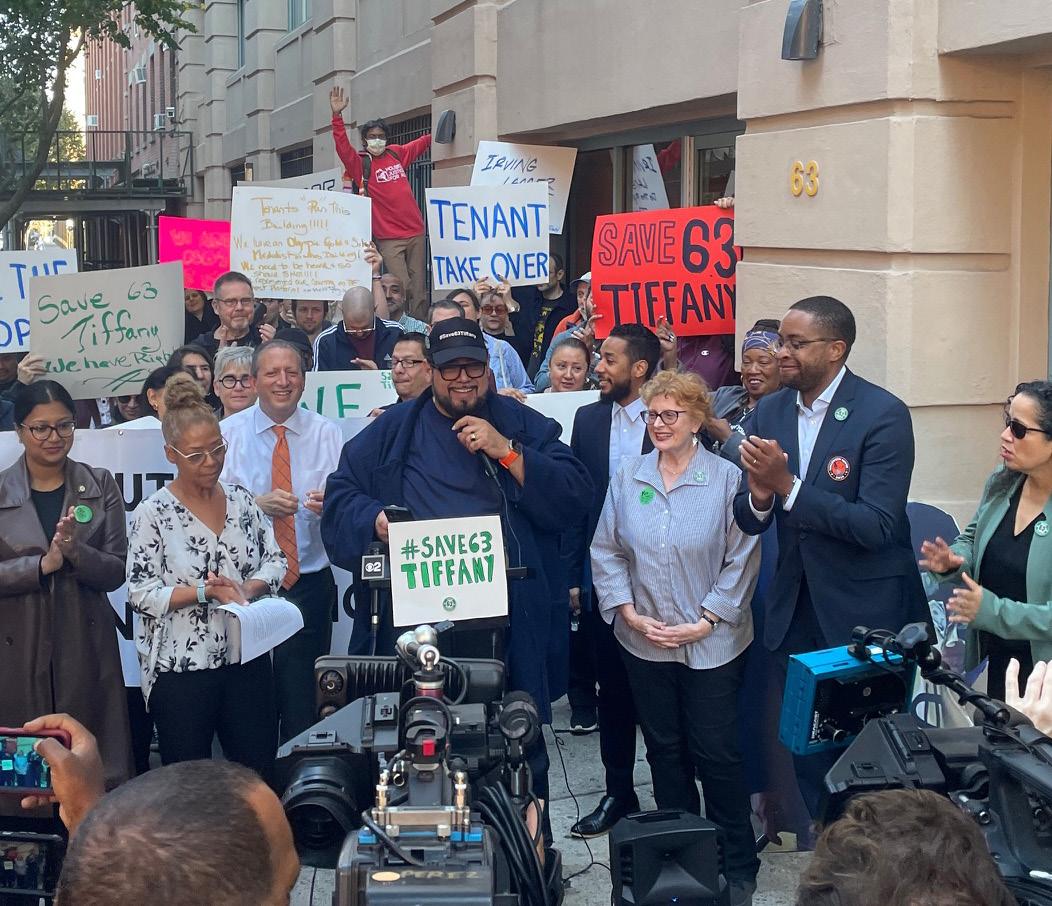
tions. TOPA “would prevent the displacement of lower-income tenants in New York and preserves affordable housing by providing an opportunity for tenants to own or remain renters in the properties in which they reside.” COPA “would allow community land trusts and nonprofits a first right to buy property when up for sale. COPA
(continued on page 13)
(continued from page 6)
ups use the best available science to protect public health and the environment, both during and after the cleanup is complete,” the agency wrote in a statement.
“The cleanup was completed, discussions on supplemental work is ongoing,” Alexander Starr, National Grid spokesperson, wrote in an email, referring to the initial cleanup plan which was completed before DEC demanded additional work. He also did not offer any further details on the timeline for the supplemental remediation efforts.
With no clear plans or timeline for the cleanup on the horizon, this also means that the development of the nearly 1,000 affordable housing units that make up the housing portion of Gowanus Green is also, effectively, on an indefinite hold.
The plans for Gowanus Green date back about two decades and became a reality in 2008, when the Gowanus Green Development team, a joint venture between Fifth Avenue Committee, The Bluestone Organization, Hudson Companies and Jonathan Rose Companies, won a Request for Proposal issued by the City of New
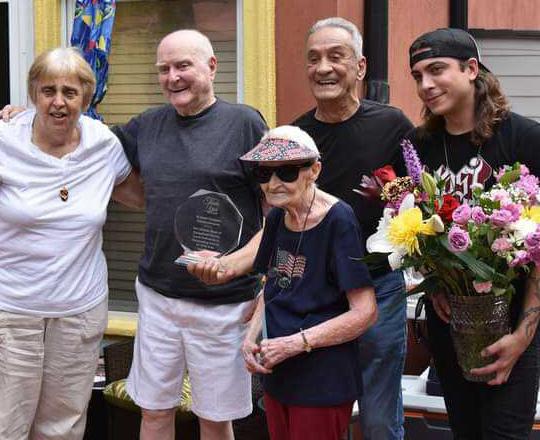
by Brian Abate
Patricia Wirth Sweeney, affectionately called “Patsy” and “Pat” passed away in Red Hook at the age of 93 on Oct. 15. She was born on June 27, 1931.
“She always said she was born in Red Hook and that she was going to die in Red Hook,” said her son, Thomas Wirth. “She loved Red Hook and she took a lot of pride in living here. She loved Visitation Church. She was baptized there, made communion there, made confirmation there, and got married there twice.
Pat was a lifetime member of the Ladies Auxiliary at the VFW and spent several terms as Madam President and then became Treasurer. She remained in the role of treasurer until she was 90.
“Pat cared so much about everyone and we all love her,” said Casey Magee of the VFW.
In addition to her time spent at the VFW, Pat spent several years working for the beverage company that used to be in Red Hook, White Rock.
“We became friends when I joined the Rosary Society at Visitation and then we
York. The project then became part of the Gowanus rezoning, an initiative spearheaded by New York City Comptroller Brad Lander, a former director for Fifth Avenue Committee who at the time was the council member for District 39. After the City Council passed the rezoning in 2021, the city and the involved parties officially announced Gowanus Green.
Since then, few pieces of substantial news about the development have come out and it remains uncertain when it will be finished. One of the developers, Hudson Companies, notes on its website that the project will be completed in 2027, but there is no information indicating whether that estimation includes the recent delays. Phone calls to Hudson Companies and Jonathan Rose Companies went unanswered. Brad Lander’s office also did not respond to requests for comment.
Michelle de La Uz, executive director of Fifth Avenue Committee, wrote in an email that construction will start “once the path forward on the additional environmental remediation has been decided, seemingly putting the onus on DEC and National Grid. “Residents are expected to begin to move in 2-3 years after construction of each of the individual 6 residential buildings has begun,” de la Uz added. Funding seems to be trickling in, how-
both worked at White Rock Soda,” said Red Hook native Emelia Kruger. “Pat was a great person, always loyal and kind. She was a great friend to me and I really valued her friendship. Everyone loved Pat. She would always check and ask how everyone else was doing.
“We worked there for 24 years and became really close. We were in Red Hook for 12 years and then White Rock moved to Queens and Pat and two other women would carpool with me there. With Pat, you always had a lot of fun. We were always laughing together. She wasn’t afraid of anyone though, including our boss.”
Though she was very loving, Pat was also a “tough cookie” to Thomas, and used to say “Don’t make me get my Irish up” when he was younger.
“When my brother and I were younger, we used to swim down on Coffey St. Pier and we even had a makeshift diving board,” Thomas said. “When a ferry passed it would make big waves so we would jump in then. One time my mom got wind of it. She actually used to do the same thing when she was younger. When she found out we were doing it, she came down the pier, and ‘under no circumstances’ were we allowed to do that again, but of course we did.
“She was tiny and my brother and I were both a lot bigger but she had no problem coming up against us. Everyone in the neighborhood would say ‘ You don’t want to come up against her.’ When the neighborhood became drug-infested, she wasn’t going to put up with it, and she watched my brother and me like a hawk.”
Pat had an open-door policy when Thomas was growing up so cousins, other family members, and neighbors

ever. In July, Council member Shahana Hanif, successor of Brad Lander, who also has been a vocal supporter of the Gowanus Green development, announced $6 million in capital funding for phase one of construction. The announcement, however, did not include further information about when phase one may begin.
When asked about Gowanus Green and the remediation of the site, Hanif wrote in an email statement, “My office has been in close contact with NYSDEC and National Grid to monitor the cleanup timeline for Public Place,” adding that both parties are taking the cleanup seriously and “are
frequently stopped by to visit.
Annette Amendola, another one of Pat’s close friends, recalled that “She would just point at you instead of saying ‘don’t do that’ and you just knew that was it. She put us in our place, and thank God for that, she made us better people.”
Pat was also known for her sense of humor and for knowing how to make her friends and family laugh.
“The thing I remember when I saw her was she said she had a little trouble with saying curse words and she hoped God would forgive her,” said Father Johannes Siegert of Visitation Church. “She was in her 90s then. It was a little funny.”
“She loved to shop and I think that’s where I get my shopping addiction from,” Thomas said. “She was always taking the bus to downtown Brooklyn or Park Slope. I think it relaxed her. She liked to go out and have a good time but she was not a drinker. I never saw her drink.”
As a child, Pat was actually very sick
prioritizing the health and safety of future residents.”
She also echoed de la Uz’s message that the ball is currently in National Grid and DEC’s corner. “Given the current contamination concerns, our shared priority is to ensure the site is fully remediated before any development begins. My office and Speaker Adrienne Adams have supported the 100% permanently affordable Gowanus Green project with capital funding, and I am dedicated to ensuring it proceeds responsibly and transparently for the community. I will share the development timeline publicly once the respective agencies provide that information.”
with rheumatic fever and acute asthma but it never stopped her and it is a testament to her that she lived to 93 despite those health issues. Additionally, both Amendola and Kruger praised Thomas’ husband Ulisses Ramirez, and especially Thomas himself for taking excellent care of his mother as she got older.
“He is such a great son and Ulisses too,” Kruger said. “She couldn’t have had a better life when she was so sick than to have the two of them taking care of her.”
“We had a lot of hardships in my family when I was younger, and Pat and Thomas, and Little Thomas were always with us,” Amendola said. “They never left our side. That’s the kind of people they are.”
Pat was remembered not only as a loving mother of her own children, but a mother figure for many in the community.
“She loved her family, loved her church, loved her friends, loved her neighbors, and loved her community,” Thomas said.
Goings on: Good Shepherd Services partnered with AT&T for the grand opening of a state-ofthe-art Connected Learning Center (CLC) for kids and teens at Red Hook's Miccio Center. The center opened October 23. The CLC offers high-speed internet access, desktop computers, laptops and high-quality educational tools and programming. The photo (below left) features Hal and Frances Brown, who were two of the ribbon cutters that morning.
The 12th Annual Barnacle Parade, which started off as an ad hoc celebration of hurricane recovery, took place on Oct. 29. The photo to the right features a bus float celebrating the community effort to get the MTA to give us an express bus to Manhattan that would go through the tunnel. Nico Keane and Maria Nieto are driving.
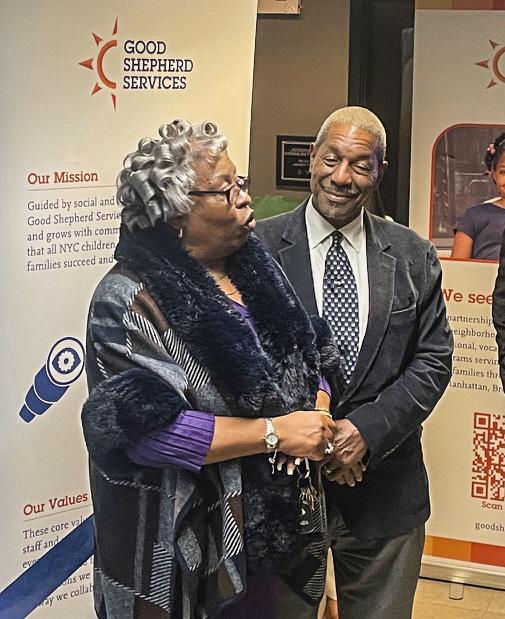
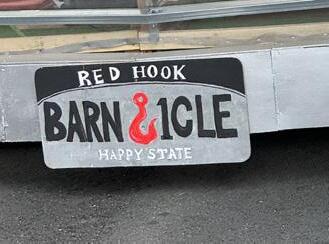

After last month’s heavy political discourse, I decided to keep it light this month and just ask people, “What is your favorite thing to do?”
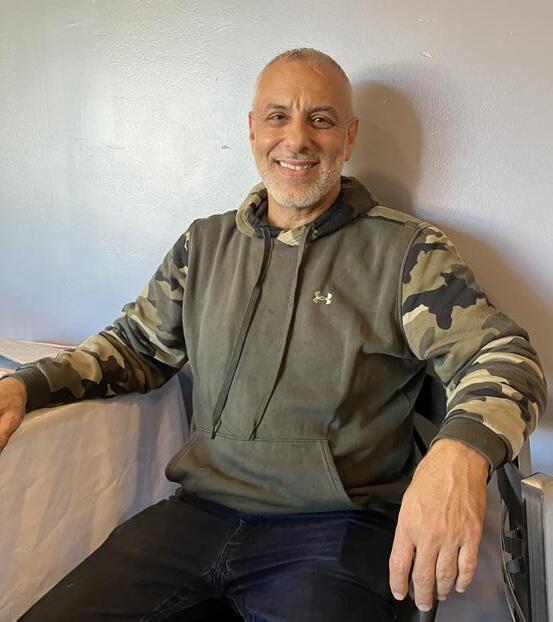
I met Mike Zokari at the Wraptor Restaurant and Bar on Columbia Street, just off Hamilton. He was talking business with the owner, Enrique Barranco. Mike owns the recently opened Columbia Deli next door.
What is your favorite thing?
Mike: Working out, going to the sauna. After work, I take all my stress, I work out, I feel at peace. It’s a beautiful thing. I love the steam room. All the stress just melts away.
Where do you work out?
I go to Harper’s Fitness. There are a few of them but lately I’ve been going to the one in Bay Ridge. They have everything I need.
You look healthy.
I’m fifty-nine.
How often do you work out?
Well, the good news is I used to go almost every day. The bad news is, since I opened the store next door, I haven’t been there. Opening a new business, it’s not easy, you work a lot of hours. My goal is to open the store at 6 am and work until noon, six hours a day. But now, sometimes I’m working twelve hours a day, from six to six.
When you do work out, what equipment do you use?
I jog (on the machine) for 30, 40 minutes. I work out with the free weights. I do pull-ups.
I next wandered over to Coffey Park and caught sight of Council, the gardener.
Council:
My favorite thing is gardening. This has been my park for over five years.

Your our job is to maintain all of Coffey Park?
I do all the gardening. Tell me what you do. The trees were already here. I do all the beds. I get to choose all of the plants. I used to get a lot of plants but they stopped giving me plants, so now I grow everything by seed or bulbs.
Is it more challenging to grow everything from scratch?
The only thing that’s bad about it is the rats are taking over. But I’m just letting them be, as part of nature.
You’re the first person that I’ve ever talked to in my life that has said anything nice about rats!
That’s right. But what’s really making my job harder is this drought.
It hasn’t rained in so long. In a long time. Everything’s been shriveling up. I’m trying to bring back life to the plants. That plant over there was shriveling up a few min-
I love showing him things and watching him learn from me. Going from not responding to saying “yes,” and “Mama”, and “Poppy,” and knowing who his primary caretakers are. His grandfather is really involved in his life too.
Grandparents are incredibly important to children. Yes. You need them.
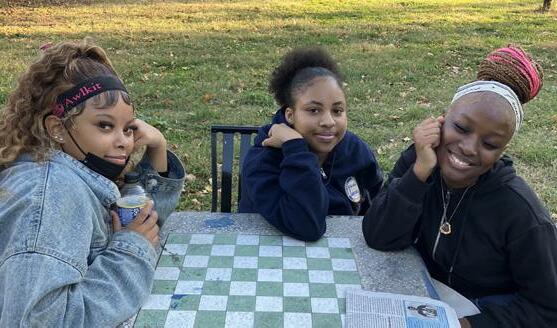
I interrupted three young women having an animated conversation around a checkerboard table: Ocean: I like to dance. The
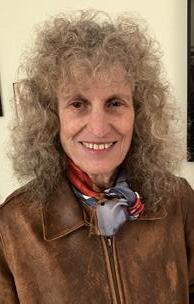
Where we talk to anyone. This month we hung out at the Ice House.
utes ago before I watered it. That evergreen over there is turning brown. Evergreens don’t turn brown.
What do you do in the winter?
Everything turns to dirt in the winter. I have to prune the trees. It all has to be cut back.
Do you work on a freezing cold day?
Yeah. All day. Unless it snows.
That’s the only break I get.

Raphael Nunez was tossing beanbags with a buddy: Raphael: My favorite thing to do is spending time with my family. With my wife and my baby boy. And how old is your baby?
He’s twenty months.
What is his name? Gabriel.
It’s a great name. Tell me what you love about hanging out with your family. After we had my son I realized I was really meant to be a dad. I didn’t know I needed this before…
What are a couple things you love doing with him?
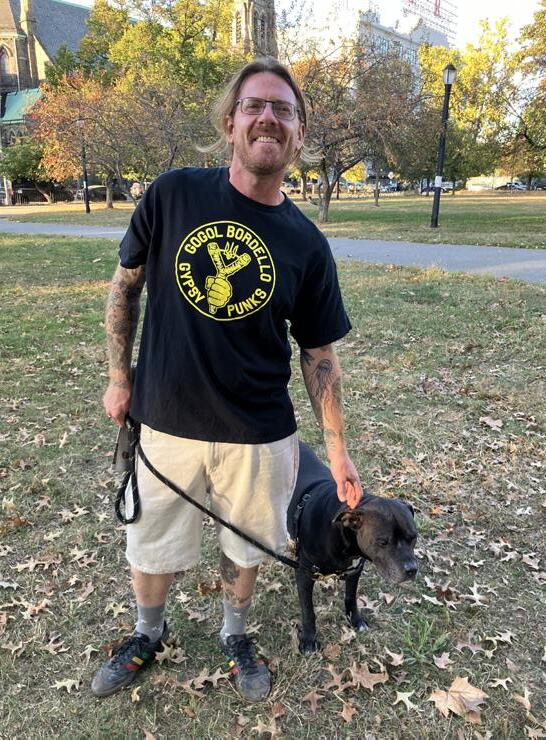
kinds of music. My favorite thing to do ever is finding new bands, finding old bands, just finding music I like, going to live shows…
What is a recent great musical experience you haved?
I do music production, but I’ve also been getting back into the Bouncing Souls, a punk rock band from New Jersey. They have New Jersey roots, but they grew their following in New York City. I saw them in the summer at the Stone Pony (in Asbury Park, NJ) for their yearly party called “Stoked for the Summer.” It’s like a big family reunion. Lots of friends meet up…They used to put on this show in December at the Stone Pony called Home for the Holidays, and this December they’re going to be doing it again, for the first time in nine or ten years, to celebrate (the band’s 50th anniversary).
When did you discover this band?
In 1994 when I was fourteen. I’ve known them for 30 years. These are good friends?
style doesn’t matter. I like to come up with things, different moves…
When did you start dancing? When I was twelve years old. I’ll bet you’re a great dancer. (Turning to Joelle) And what is your favorite thing to do?
Joelle: Sleep.
Tell me more about why you love to sleep.
Like if I’m bored or something, and I go to sleep, I can wake up hours later and be totally relaxed. When I sleep I can just be by myself, I don’t have to worry about anybody else, I don’t have to talk to people.
I can relate! (To Shamya) What’s your favorite thing?
Shamya: I like to do hair. Your hair is very distinctive. Are you a professional?
No. I do my friends’ hair and my family’s hair. I do ponytails, braids….
Ryan Duffield was walking his sweet old dog, Nesta, which was Bob Marley’s middle name. (Who knew?)
Ryan: My favorite thing to do is to listen to live music. I love going to concerts, I love listening to music, I love all
right before Covid happened.
So you’re a musician as well. I can play bass, drums, guitar -- I can play a little bit of all the instruments.
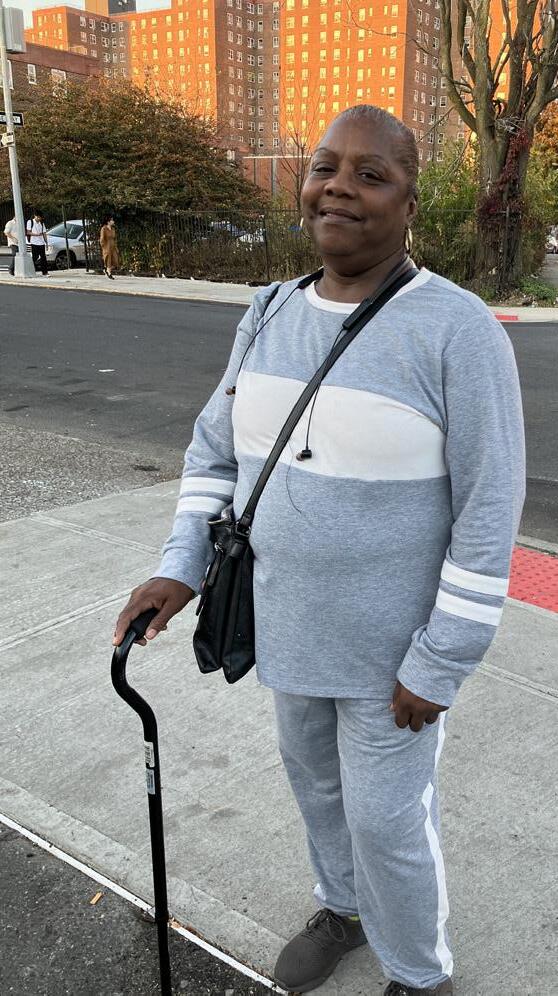
I left Coffey Park and drove to the corner of Wolcott and Richards and looked for a woman to talk to after all those men. I saw Angela Felder standing outside a car and asked her what she loved to do.
Angela: I love to walk. I love music. And I love going to church.
You love to walk. Can you elaborate on that?
I don’t like sitting still. I like going outside every day. I don’t care if it’s just walking to the store and back, getting fresh air…
And you enjoy it. It’s not like a chore. And say if there’s a big snow storm… I’m still going outside.
Yeah. The bassist is one of my tattoo artists. One of their photographers, Josh, was the wedding photographer at my friend’s wedding.
What is a concert that you’ve gone to that you’ve really enjoyed? I just saw the Rolling Stones this summer…
The first concert I ever saw was the Rolling Stones! My father took me. My dad always laughs at me, saying why do you like music so much? I say, what do you mean? You took me to see the Grateful Dead when I was like eight or nine years old! And in 1989 you took me to see the Rolling Stones at Shea Stadium! I remember that Living Colour, the Afropunk band, opened for the Rolling Stones. The Stones always like to have these, like, alternative openers. Living Colour recently did a benefit for H.R., the lead singer of the Bad Brains (a DC punk band) at the Brooklyn Bowl, and they covered all Bad Brains songs.
So music is your great passion. You said you produce music as well as listen to it. I do music production. I do sound engineering. I also play music. I played bass for Spike Polite and Sewage for a year,
And you also love church. I go to church every Sunday. I go to Greater Faith Ministries on Atlantic Avenue. I’m a deaconess and a trustee.
So you’re very involved in your church. What is it that brings you joy about going to church? I mean, I know, God and everything…
Well, the message from the overseer is very powerful.
What’s an overseer?
She brings a powerful word from God into real life. She doesn’t just talk about God, she brings the world of God into the situations you’re going through. Just like in the Bible. If you read the Bible, it’s all about what you’re actually going through today.
What is her name?
Charlene Nash.
And she is the overseer of your church. I’ve never heard that term.
Yes. And the pastor, who is her husband, also brings the word on the third Sunday.
How do you feel after you’ve been to church?
I feel as if all burdens are lifted.
(continued from page 6)
that is a major improvement of quality of life for New Yorkers and for our economy,” he added.
The Brooklyn Marine Terminal is the smallest of the six terminals that comprise the Port of New York and New Jersey and won’t be competing with the container terminals on the other side of the Upper New York Bay; on the New Jersey side, the terminals have the water depth and infrastructure to cater to the biggest of freight ships, something the Red Hook terminal won’t have, even in its upgraded state.
“Specifically, this solves a problem for the city,” Stamatis said. “This is a very unique facility and a very unique location, so it’s really just about focusing on the needs for New York City and accomplishing that.”
Increased maritime transport to and within the city is critical to making New York more resilient. “Heaven forbid something happens with the bridges in the future and this becomes a food security issue. That is another reason the blue highway is so important to get goods in here directly,” said Kimball.
According to Kimball, piers 9a and 9b are likely to be used for the blue highway system. When EDC asked the federal government for funding, it proposed that the two piers would be turned into a marginal pier to allow barges to dock sideways. Cargo
could then be loaded from the barges onto electric vehicles or speedboats, which could take the goods upstream to Manhattan and beyond.
Currently, the two piers are falling apart due to decades of neglect, which is part of the reason EDC and its partners are moving comparatively quickly.
“It is important that we move towards a productive master plan expeditiously. Why is that important? Every day we wait is another day that a pier might collapse,” the EDC CEO said. The project recently won $164 million in federal funding, but to secure that money, according to Kimball, there has to be a master plan for which the money can be used. They, meaning EDC and its partners, can’t move forward with repairing or demolishing the piers without knowing what the site will look like, as that affects how work is planned. EDC also wants to procure a long-term operator of the terminal as soon as possible.
Both community members and members of the task force have questioned the pace of the process. Council
Member Alexa Avilés, co-vice chair of the task force, told Brooklyn Eagle that the short timeline is “untenable” and that “it’s important to get this right and not speed through.” The Brooklyn Marine Terminal Neighbors Alliance also runs with the slogan, “Restart, slow down, listen,” citing the need for more community input and considered decisions.
Kimball insisted that work has to
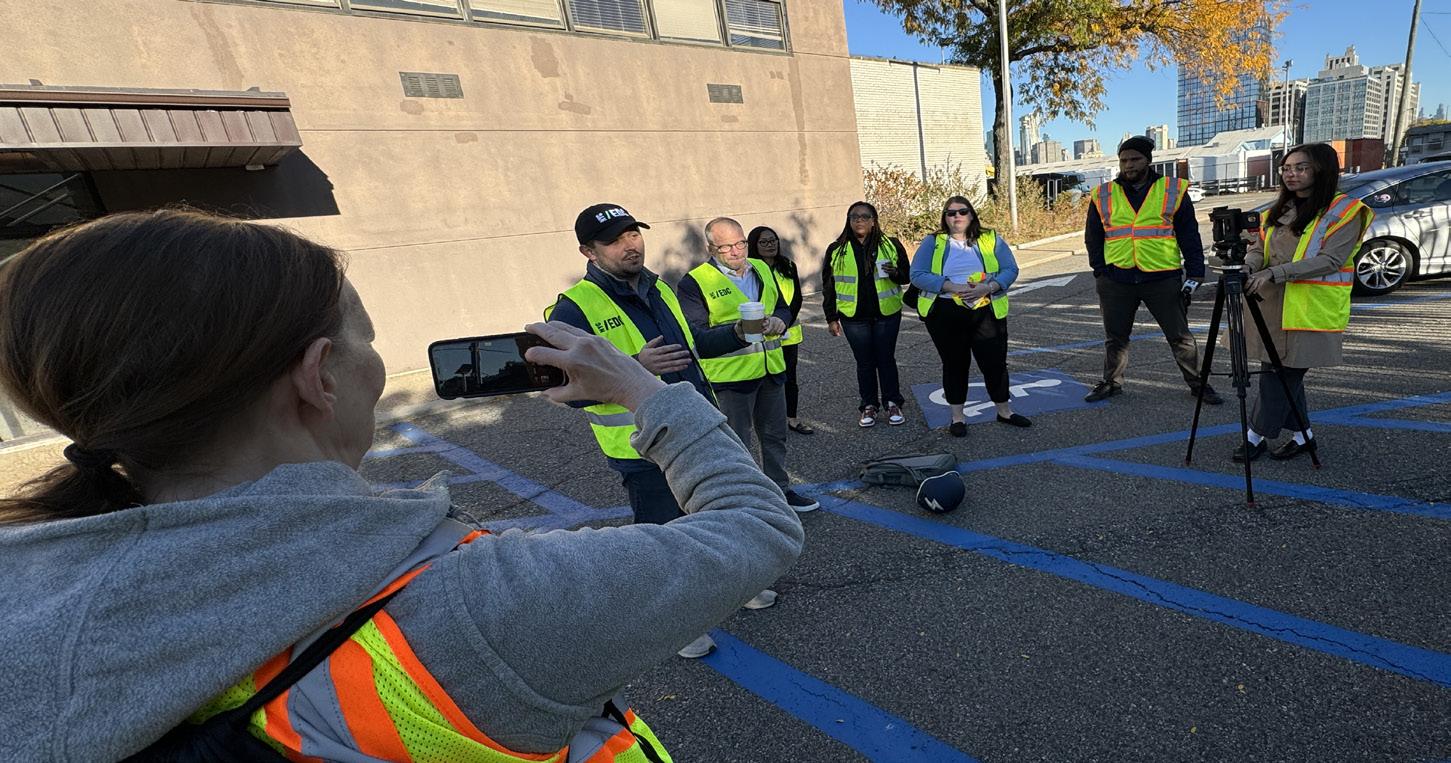
move quickly, another reason being that the redevelopment can take advantage of other city-led efforts in the area. He highlighted a climate resiliency project toward the southern end of the marine terminal as one such project.
“We need to make sure that we are integrating that properly with our master plan. The more we delay, the fewer options you’re going to have, the less coordinated those things are,” he said.
Still, based on feedback from the task force, Kimball announced that the deadline for the task force to present its master plan has been pushed to the end of March 2025.
So far, the task force has focused its work on issues related to maritime transport — short-sea shipping, cold storage, warehouses and electrification of the port — according to Jim Tampakis, owner of Marine Spares International, who has worked for decades in the maritime industry in New York and long advocated for some-
thing akin to the Blue Highway initiative. He said housing has not come up much during the initial meetings. “If they would do housing, they can’t do housing right up against the water because of the conditions of the piers. So I’m kind of happy; this way the water gets used as water distribution,” he said. “But there’s really no talk about housing at this point. We’re talking more about how to create this water distribution network and upgrade the Red Hook Marine Terminal, and then take it from there.”
Stamatis, standing on Pier 10 looking out over the water, noted that, after all, shipping in New York is not a new concept. “This is the way New York Harbor was built, why it was built. Only many of the vessels that originally were coming to this side of the harbor are now on the other side of the harbor. But, now, we need to take some of that back here directly and really build the infrastructure to support all that.”
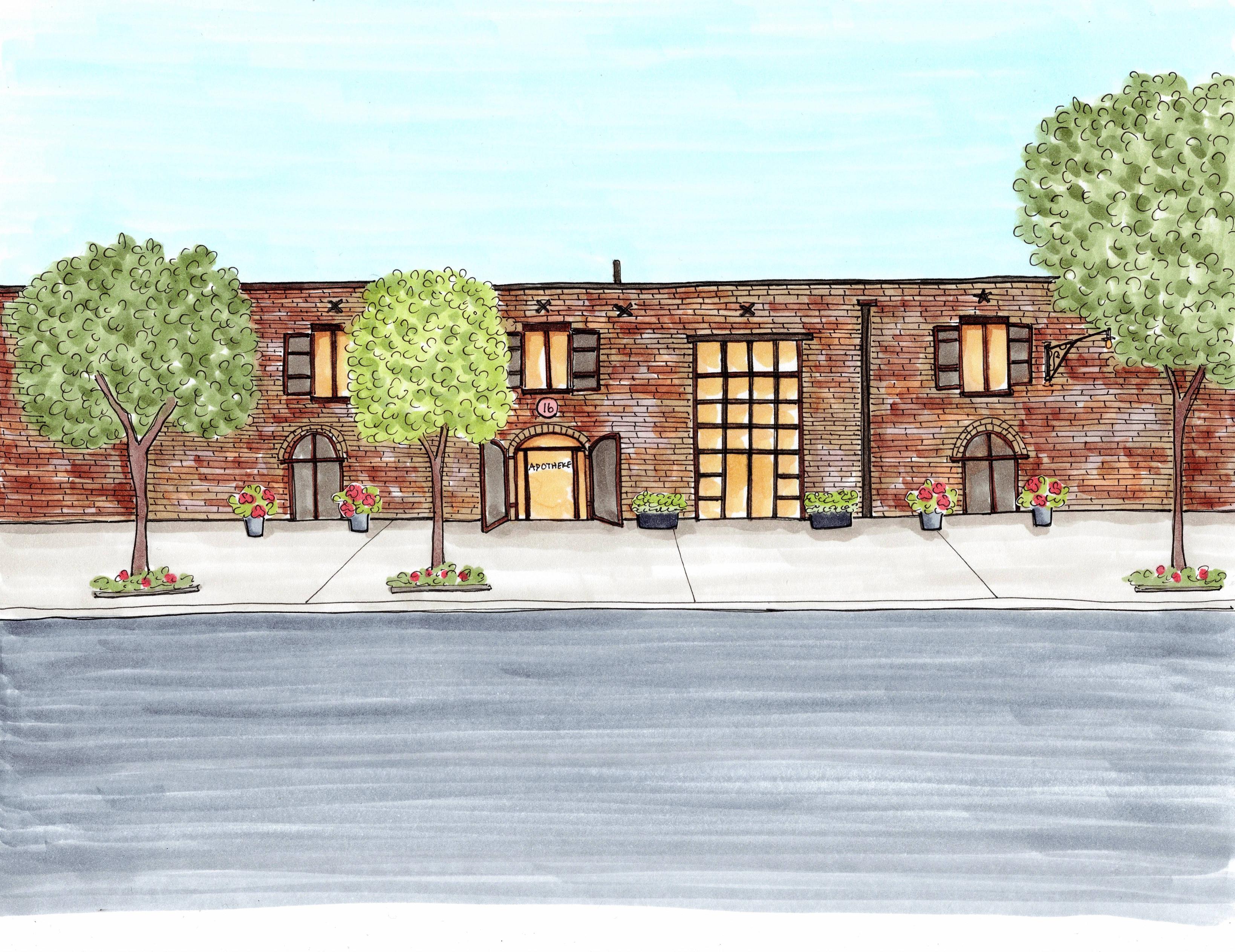

by Dario Pio Muccilli, Star-Revue EU correspondent
In the last couple of months, I had the chance to travel a lot around Europe. I spent time in Germany, Poland, North Macedonia, Albania, and Greece. Each one of this country is or wishes to be part of the European Union.
The Union has brought benefits. Germany was one of the founding countries in 1951 and has ever since enjoyed a growing economy in large part because of trading benefits that enable them to sell large amounts of manufactured goods. Poland became a member in 2004, after decades of communist rule. It has grown heavy industry (albeit polluting), and is now driving towards a digital world.
But the Union has also brought hurdles. Greece was in the throes of a financial crisis in 2011 and had to depend on EU loans. But those loans came with conditions, but the price was Reagan-style spending cuts in public health and basic services. While many Greeks wanted to leave the Union afterwards, Brussels places a lot of pressure on the weak leftist government, and
(continued from page 9)
would not only offer relief to nonprofits in an otherwise competitive real estate market but prevent private equity firms and prominent investors from flipping property or charging astronomical rates.”
“We need affordable housing, we need affordable opportunities to purchase housing, and we need housing that is built for people who live here and want to raise families,” Simon said. “What we have here are apartments where you can raise a family, not just one bedroom or a studio. They are affordable now and they need to continue to be affordable forever.”
Joy Foster, a resident of 63 Tiffany Place for 27 years, spoke at the rally.
“This is not just a New York City problem, it’s a nationwide one,” Foster said. “It’s a dire situation. There are no consequences for people who do things that potentially render people without a home. These people think those who aren’t wealthy are expendable and are only viewed as stepping stones to becoming more wealthy.”
Despite the neighborhood and local politicians repeatedly showing that they care and demanding a solution that will keep the residents of 63 Tiffany Place in their homes, it is still unclear if that will happen.
“Every time we attach profit as the main motivator for things that human beings need, people are harmed,” Williams said. “We see that in health care
Greece remains a member.
Since its establishment in 1951 with a core group of countries, the European Union has had several enlargements. Denmark, Ireland and the UK in 1973, Greece in 1981, Spain and Portugal in 1986, Austria, Finland and Sweden in 1995. Eventually in three rounds 2004, 2007 and 2013, the EU accepted thirteen more countries, eleven formerly under the Soviet sphere.
Has this enlargement worked? I would say “yes and no.” Germany’ is still the richest, but this is not such good news for other countries. Germany's export-led economy is based on others’ countries inability to develop their own efficient industries. Greece is a case in point. Their industrial and administrative capacity is really low and you can see that just by looking at the streets, which are often in bad repair and hard to drive. Work is scarce, poverty abounds and prices are up. I n Poland, technologically advanced neighborhoods with glass-walls
and we see it in housing. People have died because they do not have the housing that they need. We need to find a way to remove profit as the primary thing that people care about.
“Here we have tenants who are saying we want to own our apartments and then not being given the opportunity to do so. The negotiations that have occurred have not only fallen apart, but the owners are no longer communicating what’s going on. We can’t stand by and allow that to happen.”
(continued from page 7)
Currently, the cleanup work plan is awaiting EPA approval. As PCB levels in parts of the park exceeded 50 mg/kg, part of the cleanup falls under EPA jurisdiction; this means that the final remedy, the remediation of PCBs, must also be approved by EPA under the Toxic Substances Control Act. The work plan was submitted to EPA in February 2024, and while it’s currently not clear when federal officials will make a decision, Lanxess is hopeful to begin work in early 2025, Mackin wrote.
Parallel to this process, Lanxess recently made a deal with the New York City Department of Parks and Recreation to remediate Soccer Field 1. The two parties “outlined an agreement that identifies areas of responsibility for remedial efforts,” Mackin wrote. He clarified that Lanxess would clean up at least a part of the property but did not share how much.
buildings alternate with poor and crumbling neighborhoods. Heavy drinking is a public emergency and some basic infrastructures, like railroad, are only efficient around major cities.
Doing a trip of Europe is to see that the Union is not as united as it might wish to be. Yes, European integration has brought improvements, mostly via tariff-free goods and the promotion of rule of law. But street-level European integration is still not a thing. What would happen then if countries like North Macedonia or Albania were accepted into the Union? There, poverty is everywhere and shocking. Rubbish is poorly managed by public authorities. Public roads and public health is of poor quality. Brussels has expressed a goal to enlarge to these countries in the future, but how?
If the EU is not able or willing to deploy resources to reduce the distribution of wealth among its own members, how would it manage to level things up with the Balkans?
Chris Clark with the parks department noted, “The ongoing coordination regarding the landscape area south of the field between the Responsible Party and the regulators is not impacting the reconstruction of Soccer Field 1.”
DEC stated, “Lanxess is working with NYC Parks to clean up the park in conjunction with the park rehabilitation project. This is the most efficient and cost-effective sequence to reopening the park.” Lanxess has also agreed to clean up the cadmium contamination in the park under an interim remedial measure, following a deal with the city parks department.
Why so little has happened at a site that for decades has been a known source of cancer-causing chemicals remains unclear, however. Mackin claimed, “Defining the full nature and extent of off-site impacts, and developing a strategy to protect human health and the environment, has required substantial time and effort,”
Someone, notably Mario Draghi with his 2024 Competitiveness Report, says that EU needs a huge fiscal capacity. That means money to invest. But where shall that money come from? From the richest country, Germany above all, but also the Netherlands, Sweden and others known as the frugal group.
Those are states who benefited the most from the integration. But go ask them for money and they would pretty much say forget about it. "It’s the poorest countries’ fault!," they will say. "They’re unable to handle themselves and they go too easy with money."
As long as these misconceptions persist, Europe will have two, three, four and more speed rates. There’s no place for a Federalist-like Union in such a framework. It is just necessary to walk on the sidewalk in different countries to see what I'm talking about. You need a better distribution of income, but the haves are not that willing to help the have-nots.
adding, “Lanxess wants to resolve this legacy issue as quickly and safely as possible for those who live and work nearby.”
According to DEC, the complexity of the site has contributed to prolonging the investigative work that must happen before cleanup can begin. “Given the complexity of the investigation and multiple rounds of chemical sampling as part of the iterative process of a remedial investigation, the length of time for the investigation is not unusual,” the agency wrote.


by Marie Hueston and Sage Hueston
Thanksgiving is one of our favorite holidays. From eating delicious food to spending time with friends and family, it’s always a lot of fun. This year, make everyone at your Thanksgiving table feel welcomed with adorable turkey place cards! Here’s how to make your own.
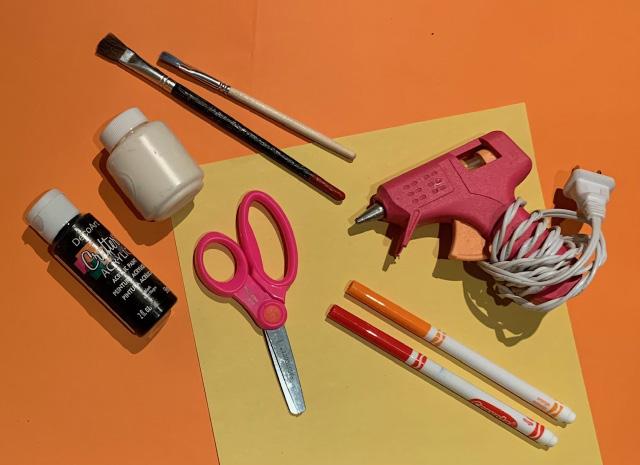
What you’ll need. In addition to your coffee up sleeves, you will need red, orange, and yellow construction paper, scissors, a glue stick or tape, a pencil, and a sharpie, marker or paint pen.
Draw your feathers. Using a pencil, draw six feather
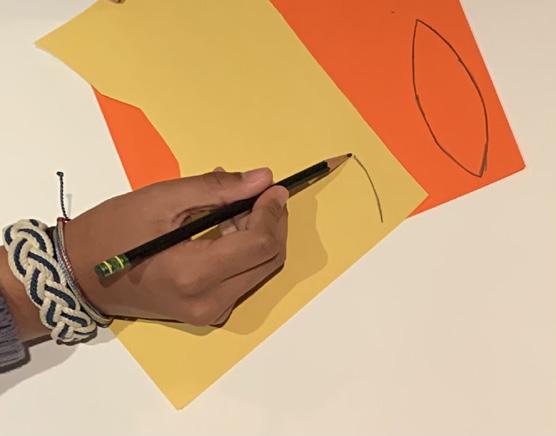
shapes similar to the ones in the picture. Make two of each color of construction paper and make them long enough so they will stick out of the top of the sleeve. We made ours about as long as the width of the sleeve.

Cut and glue your feathers. Cut out your feathers along the lines you drew and erase
by Brian Abate
The ninth annual Red Hook Open Studios took place the first weekend of October with a kickoff Scrappy Reading event. Artists and makers throughout the neighborhood open their studios and give the public a chance to see (and buy) their work.
The Scrappy Reading event took place on Van Brunt Street and featured Jax Preyer, Dean Haspiel, Lilly Dancyger, Niguel Dottin, Deborah Copaken, and host Farah Faye. Readings addressed the question: What does scrappy mean to you?
There are some great studios off the beaten path, including Green Lung Studio at 22 Commerce. Curator Sam Patrone is also founder and creative director of Chain Link Productions.
“This is ‘The Underground’ exhibit, and it includes graffiti and street art, and how it has become a global artistic movement,” Patrone said. “We have some work by Al Diaz, and we have a replica of a piece that he made in a subway station using subway tiles which was really cool.
“We also have pieces by SJK 171. Steve the Greek is an original, and he actually grew up with Diaz in Washing-
any remaining pencil marks. Once all your feathers are cut, lay them out and decide what order you want to place them in. Using either a glue stick or tape (we used glue) attach the bottom of your feathers to the inside of your coffee cup sleeve so the feathers stick out from the top.

Make your beak. Cut out a small triangle from either your red or orange paper. Then use a glue stick to adhere the beak to the front of the coffee cup sleeve.
Personalize your turkeys. We kept our turkeys simple,
ton Heights. We have a piece that he did for the 9/11 memorial that the city commissioned. His father was a very prominent photographer. He would document everything as it happened so his stuff is very historically accurate right down to the times and the dates.”

A couple who stopped by Green Lung Studio said that they wanted to check out “as many of the studios as possible.” They said that they were able to find ones like Green Lung Studio thanks to the map on the Red Hook Open Studios website.
“It’s really cool seeing a different kind of art from what I’m used to,” said Michael from Cobble Hill. “That’s the beauty of this.”
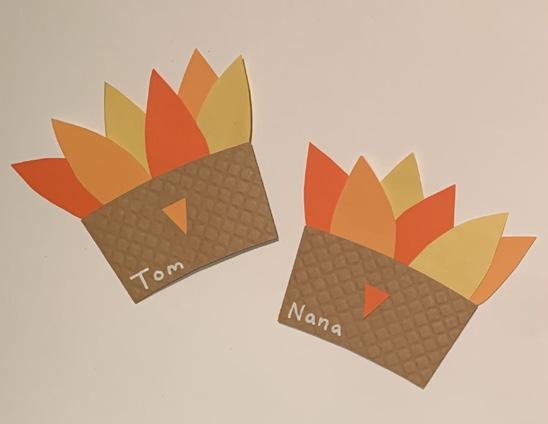
but to further decorate your turkeys you can add craft feathers, googly eyes or handdrawn eyes, or a red construction paper wattle. Lastly, with a sharpie, marker or paint pen of your choice, write the names of your Thanksgiving guests in the bottom right corner of each place card.
December Preview: Start saving colorful plastic bottle caps for a holiday craft!
Amy Helfand displayed her unique artwork. Lately, she has been focusing on ceramics, making the art in her studio, and then doing the firing and glazing at Dikeman Street's Piscina. She also designs hand-knotted rugs which are theyn made in Nepal.
“I have had my hands in clay over the years but I got more serious about it in around 2017 or so when I started doing hand building,” Helfand said. “I really connect with the process of hand building. I like the idea that with ceramics it’s a little bit like writing in the sense that all you really need is a pencil and if you’re hand building ceramics, you don’t need much. I love the physical activity of it too since a lot of my work for the rugs ends up being digital.”
Many artists displayed at Brooklyn Waterfront Artists Coalition.
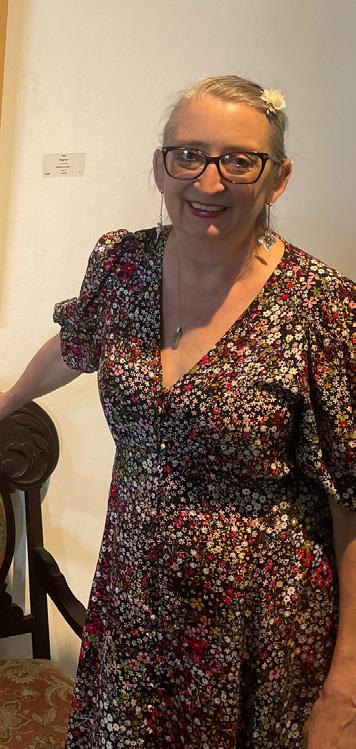
“I do a lot of South Brooklyn landscape work including this one of Lenny’s Pizza and I also do Manhattan,” said Alicia Degener, BWAC's president. “I do bridges, brownstones, Coney Island, and I’m doing a pizza series.
One couple in attendance said they came to “enjoy the artwork and the perfect weather.”
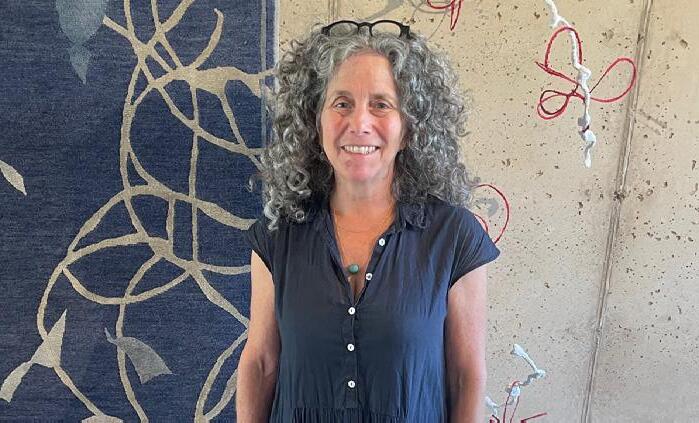
There were also a lot of people a few blocks down at Door 14 Studios where Deborah Ugoretz, a founder of Red Hook Open Studios, had her artwork.
“I did a piece called ‘The World Is Upside Down’ which is about the Hamas attack on Israel, and the response by Israel and all of the death and destruction there has been,” Ugoretz said.
“On a lighter note, I’ve been doing a series of bears based on my experience spending part of the summer in Massachusetts. This particular painting, which is a little bit like Maurice Sendak, is this fantasy I had of bears coming in the middle of the night, putting their paws on your eyes, and taking away your nightmares.”
“Open Studios is in its ninth year and every year audiences grow and it brings in more and more people from New York City and New Jersey,” Ugoretz said.
“Every year it gets better and better and I think it really rejuvenates the neighborhood. It brings business to businesses and it’s always been a great way to reveal the mysteries behind these great buildings. It’s always special but next year for our tenth anniversary we want to make it extra special.”
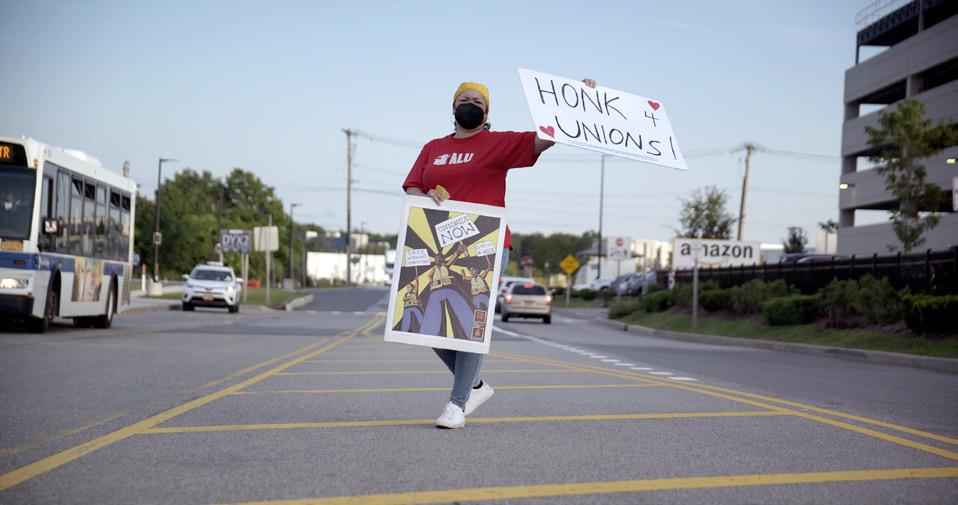


by Dante A. Ciampaglia
Our tech-dominated society is generous with its glimpses of dystopia. But there’s something especially chilling about the captive audience meetings in the documentary Union, which screened at the New York Film Festival and is currently playing at IFC Center.
Chronicling the fight of the Amazon Labor Union (ALU), led by Chris Smalls, to organize the Amazon fulfillment warehouse in Staten Island, codirectors Brett Story and Steve Maing show us what it’s like inside. Workers at conveyor belts mechanically keeping packages moving. workers asleep in break areas. In one case, a worker bundling up to sleep in her car, her home for the last three years, parked in a warehouse garage. Experiences like these fuel the ALU, which Smalls began after being fired in 2020 for leading a walkout protesting conditions at the height of the pandemic.
While the scenes of Smalls and his small team of organizers hustling for support and votes are heroic, it’s Amazon’s reactions that are most eye opening — especially the anti-union indoctrination sessions led by union-busting consultants. About 15 minutes into the film, a worker captures shaky phone footage as she’s pulled from her job on a line surrounded by heavy machines, led through industrial corridors, and deposited into a conference room. A video implores her and her colleagues to reject the ALU. “We’re proud of our track record together,” says a disconcertingly cheery, and mildly threatening, male voice. “The ALU has no track record. They never represented any employees anywhere. All they have is promises. But they can’t guarantee anything. We’re asking you to do three simple things: Get the facts, ask questions, and vote no to the union.” It’s an absurd Orwellian moment that wouldn’t be out of place in THX-1138 And if the patrician message weren’t clear enough, later an actual human actually says, “We don’t feel like you need representation.”
The ALU ultimately won its election in April 2022, which Amazon steadfastly refuses to recognize and continues challenging in court — along with every other unionization effort confronting its various interests. But what makes Union vital is the journey to that victory. This is living history, a warts-
and-all inside look at the contemporary labor movement, its challenges, and its opportunities. It’s a necessary piece of documentary filmmaking that will only grow more important as Amazon and companies like it tighten their grip on their employees’ rights to organize.
Co-director Maing spoke with the Star-Revue about the film and what it has to say to us now and in the future. The conversation has been edited for length and clarity.
You and your team were there for, essentially, the start of this organizing campaign. That seems extraordinarily rare.
I feel like the way things go is, you’ll see a group of people start to come together and slowly understand what their capacity and their potential and, really, what their goals are. Before Union, I had been filming Crime + Punishment, a project about New York’s NYPD whistleblower cops. This group of minority active duty officers had come together to gather evidence to prove the policing practice in New York City was structurally biased and racist and that they were being pressured to meet a productivity quota for summons, arrests and stops. That movement was many years in the making. I had spent, like, three years getting to know these cops and then making a few different shorter projects before gaining greater access to be able to film this entire effort for them to wage this class action lawsuit against the NYPD. That was an additional four years. I think there was something very similar in the process of Chris and his cohort taking the year to kind of organize and push back against Amazon and call out Jeff Bezos’ practices before then deciding, “You know what, we could actually form a union here.” Brett Story and cinematographer Martin de Chico came into this in the spring of 2021, and I came on as co-director shortly after that, and we were basically in place from day one to document the entire campaign. That’s rare.
Recently, Amazon responded to a National Labor Relations Board complaint by saying, “All the statements Amazon allegedly made to [Delivery Service Partner] employees were protected by the First Amendment to the U.S. Constitution.” Does it surprise you that Amazon would say they have a constitutional right to union bust? When they don’t get their way, these corporations really behave no better than a petulant child. When you look at the efforts of SpaceX, Trader Joe’s, Amazon to sue the NLRB under the guise of a claim that it is unconstitutional in its
practices,, the common factor of those companies is that they have all received reprimands from NLRB for firing and retaliating against workers who have tried to unionize. That’s a really a powerful linkage, and we have to kind of take stock of the fact that these companies will stop at nothing to stop the unionization wave. We saw Amazon spend about $14.2 million to try and stop the Amazon Labor Union. They employed countless labor consultants, who, as we
'It’s a really remarkable moment to see that an organizing group of, like, no more than 10 people with a crowdfund of maybe $125,000 was able to defeat a multi-million dollar effort."
know, are essentially just union busters, to populate the various warehouses where unionization efforts have popped up. The tactics have not changed, largely, since the Pinkertons almost 100 years ago. So it’s a really remarkable moment to see that an organizing group of, like, no more than 10 people with a crowdfund of maybe $125,000 was able to defeat a multi-million dollar effort in union busting. That’s grassroots organizing. That’s people saying we’re not going to organize in the traditional way. We are going to lean on the NLRB for all of its remaining power and capacity to protect these efforts.
There’s a tension in the nation — captured in the film — between the kind of worker-led effort of the ALU and one where a national, established union takes the lead. In Staten Island, worker-led organizing worked, but at the Amazon warehouse in Bessemer, Alabama, a high-profile effort failed. What does Union have to contribute to this larger debate about how to organize in the 21st century?
The ALU didn’t operate entirely without any support from the established unions. The UFCW, SEIU, Teamsters — they were there, and you can see them in the background of the campaign as the ALU is trying their best to fend off Amazon’s efforts to break their organizing. But I think the problem is that there are a lot of questions about, can Chris Smalls, or the cohort of the ALU, pull this off? There was a lot of hedging that also happened, even though the
established unions did lend some material and actual support.
We’re at a moment where Amazon workers are the center of the contemporary labor movement. It is minority, Black, Brown, and immigrant workers who have to not just be acknowledged but have a say in how their organizing campaigns run and the best ways to reach workers like them. As we see in the film, they never really got that confidence or sense of even trust that they themselves understood how to best reach their co-workers, who they shared lived and work experiences with. We have to take stock of being at a moment where now those workers are coming into their own. Their understanding, their political capacity and power, are the linchpin in taking on this kind of rampant, egregious, racial capitalism that we’re seeing explode in such highly extractive and dehumanizing ways.
What is the best way for established unions to support and not usurp these campaigns? To help them grow and scale up, as opposed to being offered to join and simply merge into a larger effort? How to lend support that doesn’t make grassroots organizers feel threatened by the possibility of losing control of their campaign? These are the really big questions I think the established unions need to be asking themselves. I come from a United Steelworkers household, and a union was as natural as breathing. But that tradition has been dismantled. There is greater interest in unionization now than anytime in the last 30 years, yet barriers to forming and joining a union are getting steeper. What does that say about the state of unions?
Of course we’ve seen a decline in union density over the last 50 years, and I think we have to take stock of that. A lot of people, a lot of workers, today don’t necessarily have a lot of familial or direct generational experience with unions or unions that have felt equitable and beneficial? I think there’s been a slow decline, not just in density, but also in perception of what unions offer and what they do and don’t do for workers. It doesn’t help that we live in a highly politicized moment, where we have one party that has hedged at times in its support of unions and another that entirely just pantomimes its pro-worker stance. But there is a unionization resurgence that’s happening, and I think we’re at this really exciting moment.
Union is screening at IFC Center through November 7. More information about future dates and streaming options is available at unionthefilm.com.
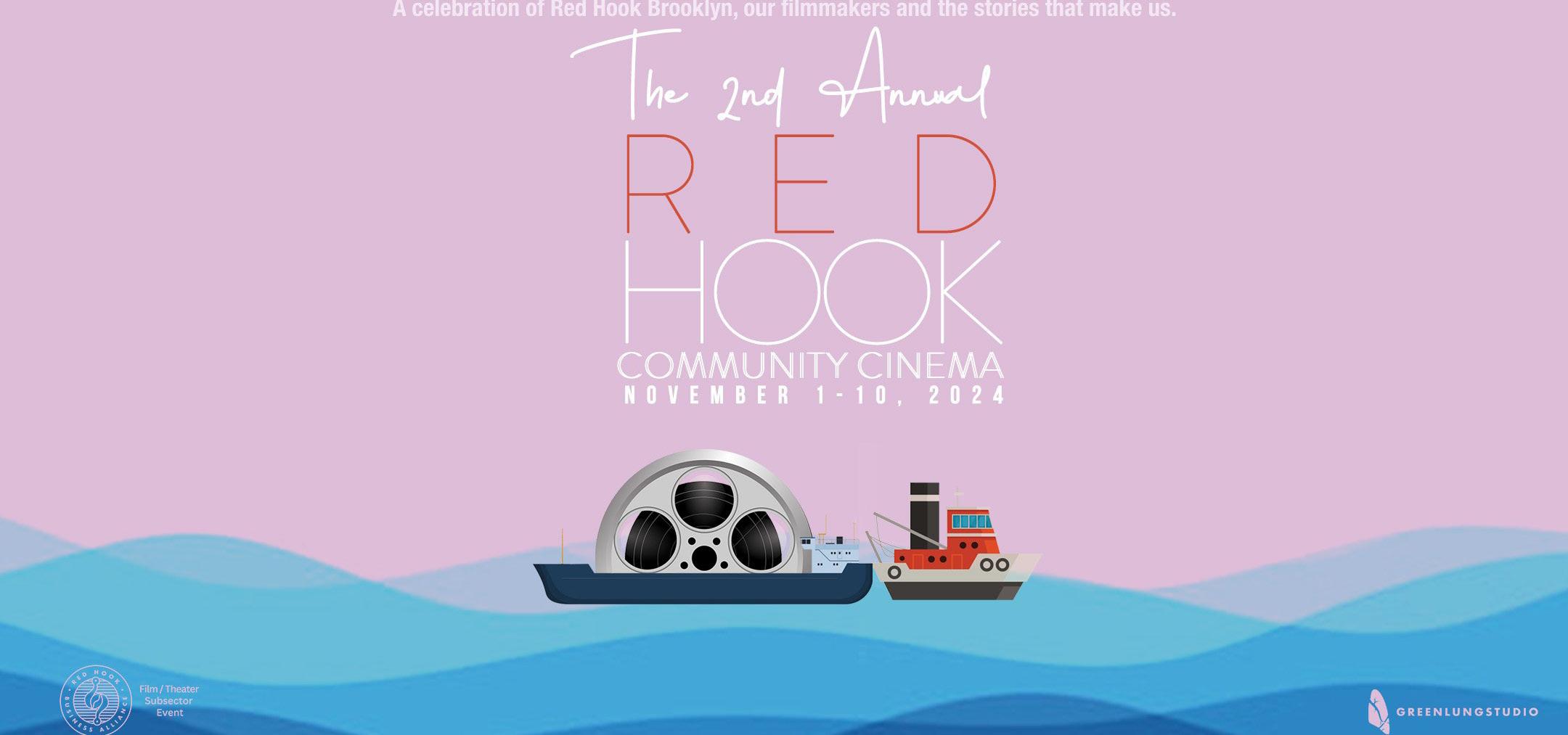
by Dante A. Ciampaglia
Red Hook is long overdue for its close-up. And this month, it gets one.
Running November 1-10, the 2nd Annual Red Hook Community Cinema film festival showcases 25 films made in, about, or that feature the neighborhood. The series opens Friday, November 1 with Isaac Dell’s Boys at Twenty at 7 p.m., followed by a costume party at 9. Like most of the festival, the screening and party will be hosted at Green Lung Studio, on Commerce Street.
“We really want to bring attention to how strong of a film and theater industry we have here in Red Hook,” says Carly Baker-Rice, Neighborhood 360 program manager and executive director at Red Hook Business Alliance. “It’s also intended to bring people to Red Hook to support all of our businesses. And we’re really dedicated to this being a great networking opportunity for people in Red Hook to meet each other.”
The festival began last year, expanding Red Hook Open Studios program-
ming and capitalizing on its popularity. Over that weekend, there were five screenings of a few dozen films — mostly shorts, though there was one feature. They were well attended, and when Green Lung moved into the community last October from Gowanus and began hosting monthly movie screenings, it felt right to spin off the Open Studios film program into its own event.
Among the line-up this year is a buzzy debut (3 A.M., the first feature from “Spike Lee protege” Lee Davis), a high-wattage indie (She Came to Me, a 2023 film starring Peter Dinklage, Anne Hathaway, and Marisa Tomei), and a historical drama (Brutal Season, set in Red Hook circa 1948), as well as two blocks of short films. The one non-Red Hook entry is Sambizanga, a 1972 Africa-set drama directed by French filmmaker Sarah Maldoror. There are also a number of events and mixers on the agenda. They include a movie trivia night hosted by the card game Cinephile on Wednesday, November 6, at Strong Rope Brewery, and

a panel discussion on overcoming obstacles in documentary filmmaking, followed by a documentary lighting workshop, on Saturday, November 9. While the programming is the main attraction of the festival, the event is about more than screening films and talking about them. Equally important is creating a space for the many filmmakers and cinema artists in the neighborhood to get together.
“Half the battle in art making is community; it’s people to bounce ideas off of,” says Steven Carmona, who cofounded Green Lung with his wife, Amanda. (They are both in the industry: Steven is a cinematographer on independent films; Amanda is a production designer.) “Our making can be so lonely because you feel like you’re grinding away and trying to survive. The biggest thing is for the filmmakers to feel celebrated and to know there are so many people living down the street from you, so many possible opportunities for collaboration and to make stuff and not be discouraged.”
Depending on how this year’s event
goes, it could grow into something bigger than a festival, where filmmakers can show their work, completed or in-progress, year-round. But that’s down the road. Right now, the focus is on the series — which isn’t called Community Cinema for nothing.
The festival is a celebration of what Carmona calls Red Hook’s “wild mix” of artists and their “independent creative spirit.” And by showcasing their filmmaking, the event both champions who is here now and opens the doors to newcomers.
“It’s hard to get people to Red Hook,” Baker-Rice says. “But every time we do an event like this, it’s one more reminder, one more reason for people to come down here. And the more people who try it realize that it is worth that extra effort to get here.”
The 2nd Annual Red Hook Community Cinema runs November 1-10, with most screenings and events taking place at Green Lung Studio, 22 Commerce Street. A complete festival schedule can be found at greenlungstudio. com/redhookcine.


by Roger Bell
Park Stickney is a harpist who lives in Switzerland and Sunset Park. He played recently in a Sunset Park bar, solo, duet and in trio* all together a set of jazz infused miracles. His banter was almost as captivating as his music, and another of his gifts which he freely shared, The performances were a rich alchemical mix and transformed the Autumn evening into a spiritual and intellectual voyage. As the night began to arc he talked about the cultural desert of his Arizona childhood and how he had discovered the wonders of a Rubik’s cube which came to symbolize his escape and journey to a life in art. Audience members scrambled the cube he handed them and his last piece involved the performance of a beautiful and complex algorithm inspired composition played with his right hand and the solution of the Rubik’s cube with his left while explaining (as geniuses sometimes do) how simplicity is likely the most desirable outcome of art.
As an example of complexity resolved and made whole I can think of no better recent example than the 100 Works on Paper exhibition which benefits the programs at the Kentler International Drawing Space. Works came from around the globe from
Hey there Brooklyn! Welcome to “Tits Up Brooklyn!”, the first column about the musical mayhem that is happenin’ in our borough. I am musical maven Medea Hoar, your local music slut. Why music slut you may ask? Well, because, musically speaking, I’ll try anything once, and if I like it, you betcha I’ll be back for more.
Summer in the city may be over but the music scene in Brooklyn is hot! hot! hot! This past weekend in a matter of a mere 24 hours this muse enjoyed everything from bluegrass to blues to rock n’ roll.
Saturday’s final bluegrass jam of the season at the East Street Community Garden was jammed packed with musicians and audience members alike, ages 2 – 92 yrs. young. Every seat was full, and the community garden organizers had to find more as the afternoon went on. It was literally standing room only by the end. I noticed some musicians were even standing up and playing, just happy to be part of experience. Speaking of musicians, at least 15 attended that day, including a woman with a bass ukulele, a cantor from LI, two bass players that swapped back and forth, fiddle player, guitars, mandos, a resonator (aka dobro) and banjos.
Sad to see this summer music series come to a close this season, but the folks in charge indicated it would be
artists who contributed their work in support and solidarity. It is apparent that small works do not mean small ambitions. On October 19 after a month-long run in the gallery the exhibition officially closed with a gala celebration which itself concluded with a Dutch style auction.
Well over 100 artists contributed small works on paper bringing together a focused and wide ranging examination of the current practice of drawing. It is in effect, the Kentler’s annual “mission” statement and was the finest of the many I have seen over the years,
Now in its 34th year in the neighborhood providing an exemplary outlet for the art of drawing, Florence Neal co-founded the space in 1990. This year Florence announced her stepping down from the executive director position. The artists’ contributions this year seemed uniquely tailored to exemplify her long tutelage and singular vision. And the exhibition had a marvelous gestalt that held together the ever growing range of expressive possibilities of making marks on paper. Donors purchased tickets and through a random “drawing” were assigned a selection order. As the night progresses and artworks are ceremo-
back next year. In the meantime, there are two indoor/outdoor Brooklyn bluegrass jams for your listening pleasure: Bluegrass by the Bridge at Delia’s in Bay Ridge on Wednesdays and Sunday Afternoon Bluegrass at Prospect Bar & Grill, S. Slope.
After my afternoon adventure I was off to Young Ethel’s for a night of rock, punk, and topless men on stage at the Brooklyn Beat – No Class Reunion – a fundraiser for the documentary on the local scene at Lauterbach’s titled “Before it was Cool, The Brooklyn Beat from Lauterback’s.”
I caught two of the seven acts performing that night, Chemical Wedding and Franks Museum, enjoyed the very best cocktails and chatted up the Merch Girl. It was a lively party atmosphere and the music I did get to hear sounded f’ing AMAZING! Tits
Up Brooklyn Approved (TUBA)! These men and women are the OG’s of the gritty, no frills, in your face decades old rock n’ roll scene in Brooklyn. The bands were tight and could adapt to situations at a moment’s notice. Such a sense of community – “What? A broken bass? No worries, take mine!”
I think the one and only issue during the time that I was able to attend was the sound. I think it could have been done better. No judgement, ‘cause this is a judgement free (and bra-free) zone, but it’s just my .02.
Sunday in Brooklyn wouldn’t be complete without block parties and bluegrass. Block Parties just seem to pop up when the air feels a bit chilled at night but the days are warm, and the leaves begin to turn. I was just taking
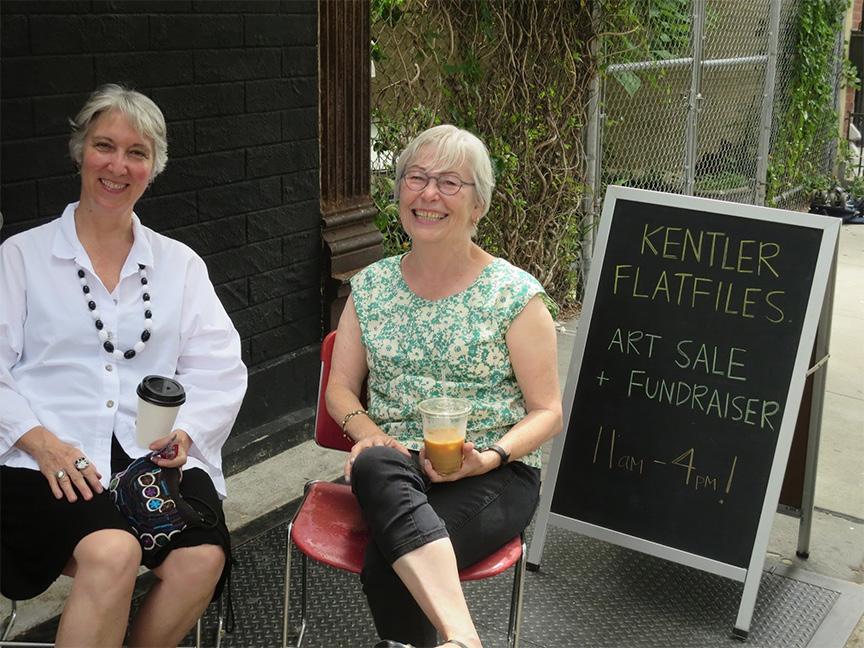
niously plucked from the exhibition the walls, the crowd both thinned to reveal the few unchosen orphans left scattered around the gallery. The erasure reveals a new range of meaning and the room seemed possessed of a strange kind of image-architecture which to this viewer revealed another simplification that asks a simple question; Are we looking at the art?, Or are we looking at the walls that surround

a stroll on a Sunday afternoon and BAM! there it was on 13th street, easy peasy and music too! The first band scheduled that day was Gig Slut (luv the name) but due to some personnel and travel difficulty, it was more of a free form jam. Super fun and easy listening, with various moving parts. I quite enjoyed it. Though it was disorganized, no one outside of the musicians really knew it, as the performers meshed perfectly. This was followed by local rockers Blastocyte, who once the vocals could be heard, were very entertaining and obviously having fun rockin’ out on the asphalt.
Because I wanted to stick with the date I came with (musically speaking only) I ended my day with the folks at the weekly Sunday Bluegrass Jam at the Prospect Bar & Grill. I just love this jam hosted by Sean Kershaw. Weather be damned, this place is good all year long. Great food, beverages, staff and it’s become a very social gathering for those with instruments and without.
With that, I leave you, my lovelies. Until we meet again on the streets of NYC, I shall remain your wordsmith muse, Medea Hoar. #bkmuses East Street Community Garden, 171 E. 4th St., Windsor Terrace/Brooklyn Prospect Bar & Grill, 545 5th Ave., South Slope/Brooklyn Young Ethels, 506 5th Ave., South
all of us and hoping the art will show a way to overcome them and free ourselves?
Darren Solomon (banjo, guitar), https://www.darrensolomon.com
Paul Brill (voice, guitar) https://paulbrill.com
by Giacomo Puccini (1858-1924)
Libretto by Giuseppe Giacosa and Luigi Illica, Based on Victorien Sardou’s play
November 16, 17, 23, & 24, 2024, at 3 PM
REGINA OPERA , Our Lady of Perpetual Help, 5902 Sixth Avenue, Brooklyn, (718) 259-2772
Free open dress rehearsal with piano, Nov, 9, at 3 PM
Free dress rehearsal with orchestra, Nov. 14, at 7 PM
Conducted by Scott Jackson Wiley, Directed by Sabrina Palladino
Performed in Italian with English supertitles
AUDREY DUBOIS HARRIS (Tosca) With a lustrous voice of extraordinary beauty and artistry of great dramatic depth, award-winning Haitian-American soprano Audrey DuBois Harris has graced the stages of the world. Tosca is both a role and company debut for her. This year, she portrayed Nedda (I Pagliacci) with New Rochelle Opera. Other performances include the title role in Aida, Mimì (La Bohème), and Tigrana (Edgar). Her portrayal of Micaela (Carmen) was called “A showstopper. Brava!” by Opera Online. She has also sung Bess (Porgy and Bess) and other operas.
by Kelsey Sobel
According to the Pew Research Center, 97% of Americans own a cellphone. In 2024, nine-inten Americans are smartphone users, which is up from 35% in Pew Research Center’s first survey of smartphone ownership from 2011.
My own relationship with technology is a standard story for someone born in 1989. I enjoyed my childhood with the most aggressive form of technological intrusions in the form of VHS movies and books on tape borrowed from the library. In 2006, I got my first cellphone, a small Nokia with no internet and T9 texting capabilities. I was entering my senior year of high school. I have no memories of me or my friends using cellphones during the school day.
We talked to each other in person throughout the day, and used AIM after school (shout out to my screen name: ReaderGirl14) or called each other on our house phones. I did get into text fights with my boyfriend and have many fond memories of the messages being broken up into nine parts since the texts were so lengthy. I bought my first iPhone around twenty, and I’ve had a smartphone ever since. In normal life as a working American, the longest period of time I go without regularly using my phone is the course of one eight hour day, when I intentionally turn the phone off to take a self directed technology break. This is usually on a Sunday. As a rule, when I go into the bedroom to read at night before bed, I set my alarm and then leave my phone untouched until morning. I do check my messages when I wake up. Although I have no social media, my weekly screen time hovers around two hours. I routinely text my mom, sister, best friend, and talk to my husband either via text or phone from the mundane, “will you pick up eggs” to live photos of our dogs. I would categorize myself as a moderate phone user. However, as someone who had a technology free childhood and loves anything nonconformist, I’m intrigued and inspired by those who are able to successfully reject owning a smartphone. Brian Sutherland, fifty three, of Holderness, New Hampshire is one of these rare cell phone-free people. Sutherland did briefly have a flip phone some years ago, which he candidly recalls, “I struggled with regulating use - I was spending way too much time using it when I should have been doing better and more important things.” A high school guidance counselor at a mid-sized regional school in the southern White Mountains, Sutherland uses the landline in his office for work calls, relies on his low-tech digital watch to set manual alarms, and uses email to communicate with students and parents. He talks to his extended family and friends from the landline at
home, and his wife and children can reach him via a Gizmo he keeps in his car (essentially a smartwatch starter for children that enables calls or texts for emergencies or communicating about family logistics.)
Although Sutherland admits being at the same school that his children attend makes things easier, I don’t get the impression he’d readily buy a phone if his kids were to suddenly transfer to other schools. His wife, a locally based primary care doctor, does own and operate a smart phone which Suther land confirms makes his choice to not have a phone possi ble.
home, find meaningful careers and independence, one has to wonder if this has to do with the technological closeness that has happened in the last twenty years between parents and children. As Sutherland notes, phones have completely changed the landscape of adolescence, a time for freedom, exploration, and most importantly, making mistakes and figuring out how to make it better. I certainly would have had a different

asked directly about his philosophy of going cellphone free, Sutherland states that since the 2000s, he has witnessed phones ruining the high school experience. From eerily silent students on field trips, to young women grappling with explicit content being circulated to the masses, to feelings of rejection when someone doesn’t immediately respond to a text or a snapchat, Sutherland has carefully tracked the destructive nature of cellphones, specifically amongst one of the most vulnerable populations: adolescents.
Sutherland’s middle daughter, who is a senior in high school, doesn’t have a cellphone. His oldest daughter got a phone when she was sixteen, and his youngest, a freshman, doesn’t have a phone either. Although Sutherland is not the type to elevate anyone to a higher status, he does admit the choice to limit his children’s interaction with technology has likely made them more successful academically, specifically citing the advantages to being phoneless in terms of attention and focus. In a school with about six hundred and fifty students, the Sutherlands might very well be the only two students without phones.
To sum up the acute danger lurking in our phones, most especially for young people, he succinctly says, “There are too many idiot things you can do with that powerful of a device. Smartphones prevent the ability to access an entire unseen world in your child’s life.” As more and more young people struggle to leave
dering Israeli citizens on October 7th, we also get stories about Hamas hostage takers treating their prisoners with great care, and we get stories of Israeli citizens showing extreme anger and hatred towards family members calling for the end of the war and the return of the hostages. None of that fits into an easy black hat and white hat way of thinking that perhaps old fashioned media allowed us to operate in.” Many of us can relate to the confusion we feel about finding authentic news but also to the repulsion we feel in our inability to turn away from the barrage.
high school experience if my mom had been tracking me on Find My Friends or Life360.
Sutherland, someone who exudes a down to earth nature says, “Phones make everyone think they are smarter and more important than they are......I don’t need to be reachable at all times. My thoughts on a particu-
“Information was a lot cleaner growing up, when it didn’t come at you from every direction."
lar matter does not need to be shared and retweeted and viewed by hundreds.”
Sutherland also struggles with the muddling of information that has come as a byproduct of smartphones being so insidious in our consumption of media. He says, “Information was a lot cleaner growing up, when it didn’t come at you from every direction, unfiltered and on a constant 24 hour 365 days a year cycle. We get stories of Hamas fighters brutally mur-
In addition to being free of the media’s chokehold, Sutherland says that he has more autonomy over his free time. When waiting at an appointment, he brings a book or watches other people on their phones. In the car he drives either in silence or listens to sports radio or NPR. Currently, the radio in his car is broken. To navigate, he uses printed google maps and when he makes a plan, he sticks to the plan avoiding last minute changes over text. Over the years Sutherland has employed the use of airport paging to locate a friend to coordinate a pickup, and utilizes an old iphone with no data for tickets to Red Sox games with his son. Sutherland does say that society is centered around the convenience of having a phone but at no point did I sense he was curious about what life is like on the other side or that the minor roadblocks are enough to deter him from being phone free.
Awaiting the birth of our first child any day, I find myself thinking ahead to the type of childhood I’d like for our offspring to have - one where they are looking outward, taking the word in, instead of looking inward to a world that is superficial, dangerous, and deeply addictive. Most terrifyingly, it’s a world I can’t control. Of course part of being a parent is letting go of control, but when I imagine a family afternoon with our new baby, the three of us on our phones certainly isn’t part of the idyllic family portrait I’m creating.
I’m sure, without needing to conduct a high level study, that Brian Sutherland’s quality of life is higher than a teenager who is averaging seven hours of screen time a day and higher then mine who is just as addicted to my phone as the next person. I’m sure he’s observing more, sleeping better, and worrying less about what other people think of him.
And if nothing else, his posture has got to be better.
Zac makes out with Vera in Bay Ridge and walks homes really late and get stopped by a cop looking for a criminal.
Luckily, he doesn't match the description and makes it to his home in Sunset Park. We learn about a joke his mother played on him when he was a six year old, leaving him with a little psychological scar. In the morning his mother wakes him, informing him that his Dad wants to talk to him about something.
“So Zak, what are you gonna do… now?”
Knowing the right answer, Zak said “I’m gonna get a job,”
“Yeah, but what job?”
“I’ll start looking tomorrow.”
Joe went back to eating and Helen spoke.
“Listen Zak, you might not have to go lookin, we might have something good for you, really good.”
“Oh yeah?”
Frank Wozny finished his lunch saying “I gotta get back to work. Listen to your mother, this is a good job for you, a union job. See you later.”
He put on his coat and left.
“Uncle Nicky’s friend Ski, you know him, right?”
“Yeah, that’s the guy who drinks beer at grandma’s house.”
“That’s him.”
(The legend was that Nick Volpe, Helen’s bachelor brother, and Pete Dombroski, known as “Shi” would drink their way going bar to bar, from South Brooklyn to Bay Ridge).
“OK, so…”
“So, Ski works in the city. He’s a doorman at one of those big buildings.”
“A doorman?”
“Yes, and there’s an opening in his building.”
“A doorman?”
“Yes, a doorman, and Ski could get you an interview.”
“A doorman?”
“It’s a really good job, especially when you get in the union.”
“A doorman?”
“Stop saying that! Why do you keep saying that?”
Zak kept saying the word because he couldn’t believe, with all the jobs in the world, they had to come up with this one.
“OK, I’ll stop saying it, but… I don’t know if that’s what I want.”
“Do you know what these guys get at Christmas, in just tips?”
“No, what?”
“Like five thousand bucks, in just tips.”
“Tips, huh?”
“Yeah, in cash.”
“Can I think about it?”
“Sure, think about it.”
Back in his room Zak lay down and stared at the ceiling. He didn’t think about being a doorman, though. He thought about Vera Sansone.
27 – Friday Night
Zak got through Friday night dinner by agreeing to everything they said. He would do the interview, yes it would be a good job, yes, he wouldn’t mind being a doorman.
“So it’s all set,” said Helen. “Ski told Nicky you should come in because this opening won’t last.”
“Monday morning ok?”
“Why not,” said his father. “You ain’t doin nothin’.”
“Yeah, ok, no problem. Oh listen dad, I was gonna go out to Bay Ridge tonight, could you let me have a few bucks?”
Zak hated asking his parents for money.
After a pause his father said, “Sure, you’re going’ Monday morning, right?”
“Oh yeah.”
Joe got a bill out of his wallet and handed it to Zak.
“Here’s a twenty.”
“Great… thanks.”
It was Friday night, he shaved, put on his Frye boots, clean jeans, and his brown bomber jacket. He went up to the drug store with a pocket full of change. It was just 7 o’clock when he dialed Shore Road 5-6622. A man answered.
“Yes.”
“Oh hi, could I speak to Vera.”
“Who’s this?”
“Tell her it’s Zak.”
“Hold on.” With the phone put down he could hear the nightly news and the man’s voice calling his daughter.
“Oh hi Zak.”
“I was wondering if maybe you’re not busy, maybe I’d come out to the Ridge.”
“Well… I’m going out.”
“Oh, ok, maybe some other….” She cut him off.
“To a party, at school.”
“Oh yeah.”
“I mean, you could come, if you’d like.”
“Really, yeah.”
“It’s at one of the dorms down at Pratt.”
“How you gettin’ there?”
“In the Falcon.”
Zak walked down to 4th Avenue and 41st Street. Vera would pick him up there in about 20 minutes. He leaned on a parked car and
watched the Friday night traffic go by. A lot of stuff to think about; a doorman, he was gonna be a doorman, and the draft, he was gonna be drafted and go to ‘Nam. Just down the street was the Gowanus Expressway, could Joey Ricciardi still be down there?
Luckily Vera pulled up in the Falcon and he didn’t have to think anymore.
“Hey, thanks for picking me up>” “Sure.”
She looked nice, in a maroon sweater with her light yellow peace symbols all over, smelled nice too, and her hair still looked cool, long on one side. They drove on 4th Avenue.
“So what’s new Zak?”
“New… let’s see.” There was a lot new which he couldn’t mention right now. “Um, well nothing, except I’m with you and we’re goin’ to some party, that’s new.”
She laughed.
“What’s new with you?”
After a pause she said “I guess… you!”
They both laughed a little. Driving north, they eventually hit Flatbush Avenue. At Lafayette she made a right into a neighborhood full of named streets.
“So this is where Pratt is, never been down here before.”
“Me neither, until I went to Pratt.”
At Classon Avenue she turned left, after a few blocks pulled into a student parking lot. Out of the car, they held hands walking to the dorm.
“You look a little taller.”
“I got my Frye boots on.”
“They’re nice.”
There was a security guard at the desk in the lobby.
“You sure I can get in here?”
“Yes, you’re my guest.”
She showed her student ID, the guard gave Zak a guest pass sticker which he put on his jacket. An elevator took them up to the fifth floor, the freshman dorm rooms.
28 – Party like it’s 1969
The elevator doors opened onto a hallway hazy with pot smoke, and ids hanging outside the open doors to their rooms, drinks and joints in hand.
“Wow, all these kids live here?”
“Yeah, it’s pretty cool.”
They walked down the hall towards the sound of a rock band. Each room they passed had it’s own mini-party going on. One had heavy incense and sitar music, kids sitting cross-legged in varying states of stoned meditation. In another, girls in mini-skirts were dancing to Motown.
“Do you know all these people?” “No, just a few in my class.”
In the large community room at the end of the hallway, a threepiece rock band was playing loudly, with wah wah pedals feedback.
Vera ran into a friend and introduced Zak, but he couldn’t hear her name.
“Is there any beer? Zak shouted. Vera’s friend pointed to a corner where there were kegs and plastic cups.
“Want a beer?” he said into Vera’s ear.
“Sure,” she shouted back.
The beer was warm and flat but they drank it. Some more of her friends showed up with joints which they smoked.
Vera yelled in his ear “Do you like it?”
“Yeah” he yelled back.
“We’re gonna go dance.”
“OK!” Zak followed Vera and her friends down the hallway to the Motown room.
“Do you dance?” she asked.
“Nah, not really, I’ll just hang.”
“I feel good, I knew that I would I feel good, I knew that I would So good, So good I got you.”
Vera’s friends had really good pot. Zak watched the dancers, mostly girls. The strobe light would go on and off and everything would be in stop motion. Vera looked at him from the crowd and smiled. He smiled back. She came over to him. They started kissing, their bodies pressed against the wall. The lights, the sounds, their hungry teenage mouths, their bodies slipping down the wall to the carpeted floor.
Breaking the embrace Vera said, “Wait.”
She got up, pulled him up by the hand, went down the hall looking for an empty room. They found one. It was divided up with curtains, behind one was a single unmade bed. Vera and Zak fell together on it and made love, beginner style love, short, but sweet and wonderful. Laying back now with head spinning softly he said “Wow.”
She turned and kissed his shoulder.
Author Bob Racioppo is a founding member of the Shirts, a New York-based American punk band that was one of the seminal CBGB bands. After signing a record deal they toured the US and Europe. In addition to music, Robert is an accomplished fine artist. This is his first novel. He grew up in Sunset Park and now lives in Windsor Terrace. To order a copy of the full book ($15) text 917 652-9128 with your address.
by Oscar Fock
It smells like harbor, I thought as I walked out to the end of the pier to which the barge now known as the Waterfront Museum was docked. Unmistakable were they, even for someone like me — maybe particularly for someone like me, who’s always lived far enough from the ocean to never get used to its sensory impressions, but always close enough for occasional day trips, and, thus, associate its smells, sounds and visuals with a few, vivid memories — the aromas of salt, seaweed and tarred rope.
On this October evening, and for most October evenings, the Waterfront Museum would temporarily take on a new role, as the stage (pardon the pun) of The Wind and the Rain: A Story About Sunny’s Bar. The play, which debuted at the end of September and ran until the end of October, is set against the backdrop of when Superstorm Sandy struck New York and flooded Sunny’s, a community staple in Red Hook for over a hundred years. It portrays Tone Johansen (played by Jen Tullock), the Norwegian transplant who married Sunny (played by Pete Simpson) and who’s been the face of the bar for years, as she fights to save the bar from water and greedy relatives.
The show is, in essence, a love story: Most prominent, of course, is the relationship between Tone and Sunny, but the narrative jumps back and forth in time and the audience also gets to follow the relationships of Sunny’s relatives as they, as immigrants over a
century ago, settle in New York. But it is also, through narrative and design, a love letter to Tone, Sunny, the bar, and Red Hook. Yet, this was more than merely a play, more than the actors and the music; this was a fundamentally human experience, and for me, it turned out to also be a profoundly personal one.
during Hurricane Sandy. As someone who didn’t live in New York at the time and had only heard recounts of what Sandy was like, these scenes gave me a newfound understanding of the intensity of the flood.
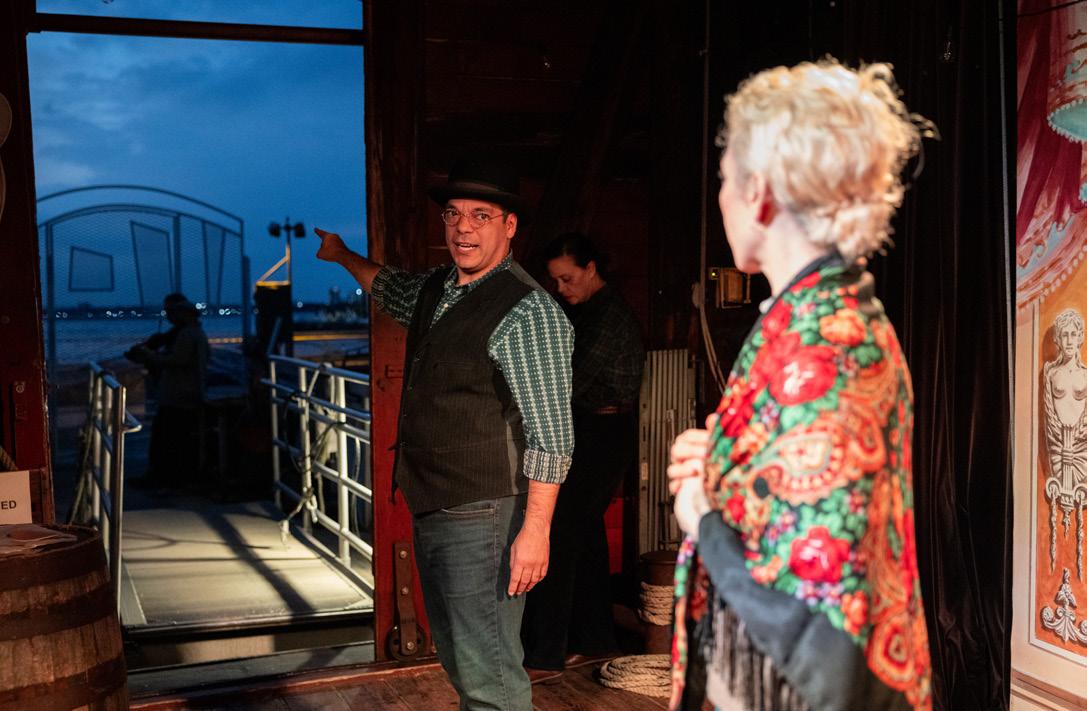
I admire the courage of director Jared Mezzocchi and playwright Sarah Gancher. When I spoke to them in September, they made it clear this was a play for the community as much as it was about the community. But even more, it is a play made by the community. Throughout the play, audience members, one after another, are invited to read a one-liner projected onto the walls. Occasionally, attendees are also brought onto the stage to briefly become part of the supporting cast; they play young Sunny, a corrupt law enforcement officer during prohibition, a loving couple out for a drink. Each participant’s tone, confidence and energy become part of the play, making each night unique, unable to be replicated. It is bold to do this, to give away control and accept unpredictability. But it works, and the trust put in us as audience members makes for a beautiful, communal creation. Mezzocchi and Gancher have created a marvelous story together, drawing from interviews, personal experiences and historical documentation to build a narrative that honors the truth without staying chained to it. I never felt the need to question if a scene was true or not, or how much had been fictionalized, as the emotions evoked established a truthfulness beyond what any fact could do. This was never more true than when the stage turned into a flooded bar
The story traverses eras, from presentday to Brooklyn’s first settlers, from prohibition to the ice age. This nonlinear narrative is never confusing, however, and some of the play’s most
"Mezzocchi and Gancher have created a marvelous story together, drawing from interviews, personal experiences and historical documentation to build a narrative that honors the truth without staying chained to it. "
memorable moments occur when moments, separated by time, come together and play out simultaneously. Indeed, the seamless time jumps are mainly due to the performances of the quartet of actors. Cast not for specific roles but, according to Mezzocchi, for being “strong collaborators and theater makers,” Tullock and Simpson and the second half of the ensemble, Jennifer Regan and Paco Tolson, bring the best of themselves and bring out the best of the audience. It is easy to understand the choice of actors: They move seamlessly between time and space and between narration and characters, caring deeply about both the story and us onlookers.
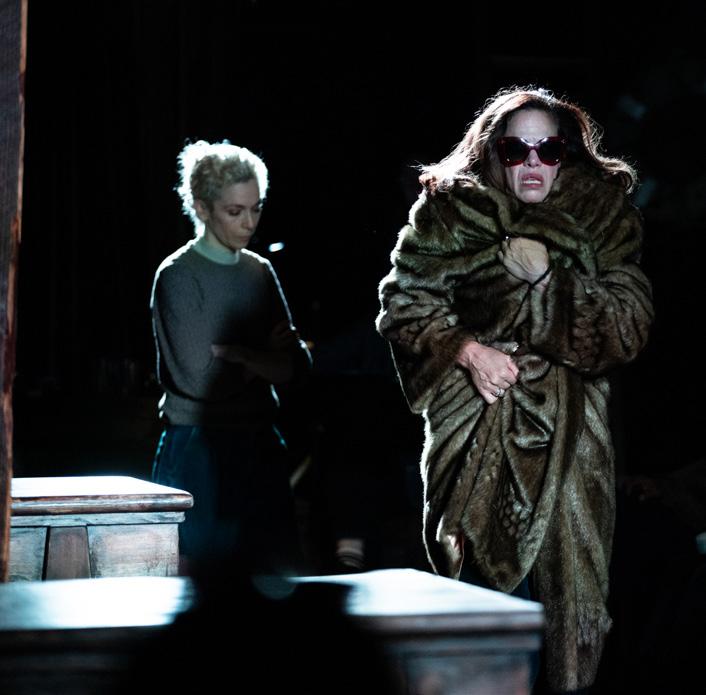
Moving the story forward and bringing the audience together is also musician
Pete Lanctot, who on this night was accompanied by local musicians Adam Winski on banjo, Sarah Klein on ukulele, and Alex Deane on fiddle. (For every show, new local performers get to be part of the play.) Just as music has become an integral part of Sunny’s Bar, it plays an equally important role in this play. Although there is technically no singalong, I found myself time and time again wanting to join in. (I settled for tapping my feet to the rhythm.)
This was an immense, almost overwhelming experience. Not because of the quality of one singular thing, or even a combination of things, necessarily, but because it made us all one. I could continue to praise The Wind and the Rain for its individual parts — the actors, the music, the storytelling and the design all certainly deserve it — but it wouldn’t make this experience justice.
So, I’ll just say this: I grew up in a country where I didn’t know my neighbors very well, and where neither of my parents or any of the other adults in my life (or me, once I got old enough) had that spot they kept coming back to because they knew they’d be around friends; today, I live on the Upper East side of Manhattan in a 4-story apartment building where neighbors change with the seasons and words beyond “Hey, how are you” are rarely exchanged; but, for one night, I was a Red Hook native, a Sunny’s regular, a member of the community. I was home. There is no higher praise I can give.
The Wind and the Rain: A Story About Sunny’s Bar is not the only play showing in Red Hook this fall. For three days (and four performances) only, Nov. 8, 9 and 10, the performing arts group Drama of Works presents The Grand Guignol Theater for Children at Brooklyn Waterfront Artists Coalition. The play features shadow puppet renditions of three of Edgar Allan Poe’s works, and Drama of Works also uses a toy theater cemetery stage to warn children of the danger of misbehaving. Despite its title, The Grand Guignol Theater for Children isn’t actually for children — at least not young ones — as it contains “animal cruelty, children being set on fire and other scary stuff,” according to the press release. The play stars Amy Carrigan, Kevin P. Hale and Scott Weber. “Is everyone ready for a bloody good time?!?”
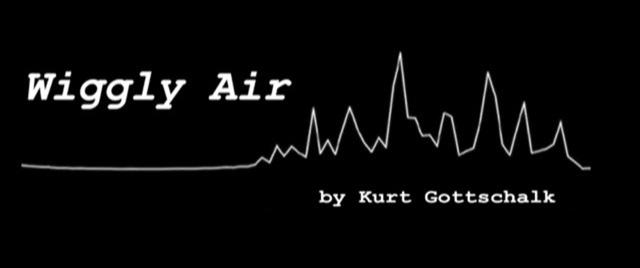
Mothers of reinvention. “It’s never too late to be what you might have been,” according to writer George Eliot, who spoke from experience. Born in the UK in 1819, Mary Ann Evans found her audience using the masculine pen name in order to avoid the scrutiny of the patriarchal literati.
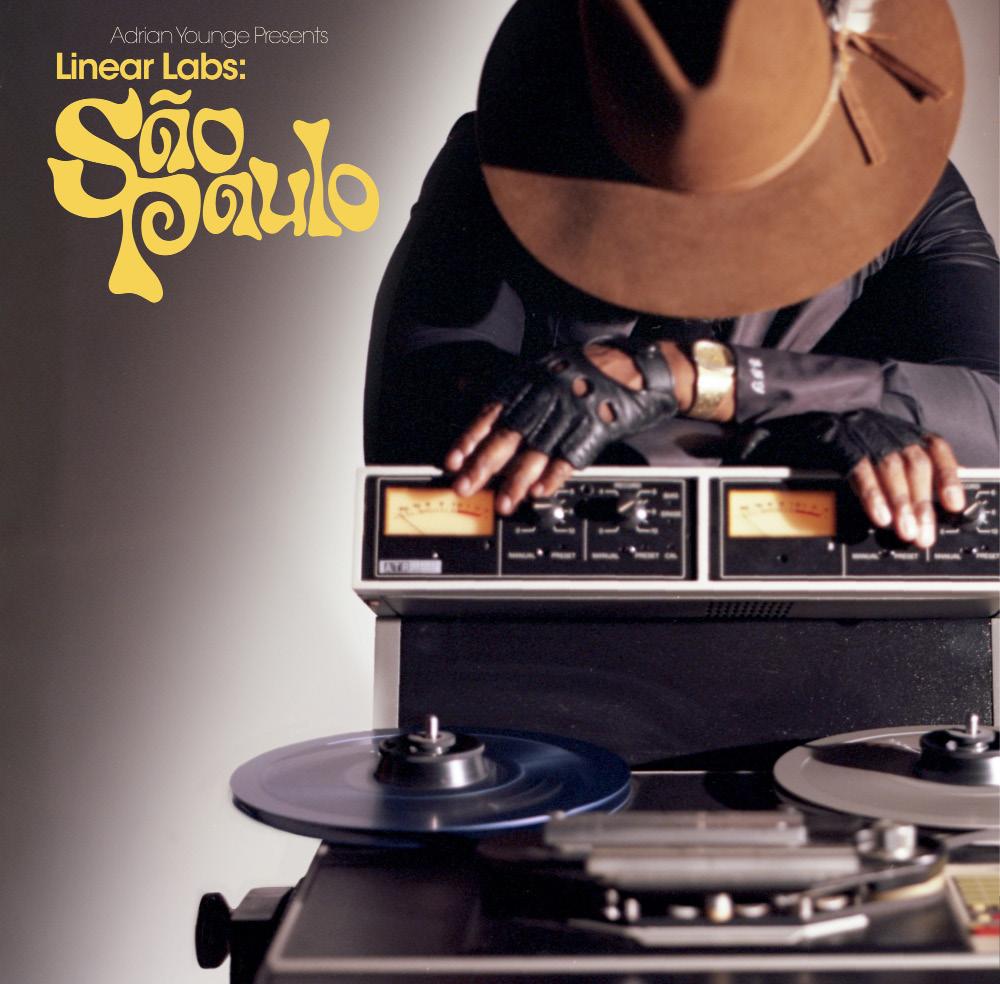
Reinvention, of style if not self, is in the air this autumn. Adrian Younge reimagines Afrobeat, samba, tropicália, Blaxploitation soundtrack and more on Linear Labs: São Paulo (CD, LP, vinyl out Nov. 15). Younge is founder of the Linear Labs label and co-founder of the label Jazz is Dead. He’s released more than 50 albums under his own name and many more as a producer. One of the most notable in that tall stack is Adrian Younge Presents the Delfonics (Wax Poetics Records, 2013), in which he teamed up with Philly Soul singer William Hart—notably the only Delfonic on the session—to reimagine the singing group in a brilliant psychedelic fantasy. A similar strategy is at play on São Paulo. With masterful pop arranging and a convincing period mix (although the fidelity is very this century). The album is actually a compilation of selections from upcoming Linear Lab/Younge productions, and it’s testament to his ear and his command of the mixing board how well it all hangs together. Vocalists include the soulful crooner Bilal, rapper Snoop Dogg, and Stereolab’s Lætitia Sadier. Younge’s taste for exotica is supplanted by Liraz Charhi (Iran/Israel) and Samantha Schmütz (Brazil). The 2025 Linear Lab calendar is, it appears, filled with retro-modern riches.
Loads of artists have reinvented their hits. Blondie, David Bowie, Kate Bush, Joni Mitchell and Taylor Swift are just some of the many who have updated and rerecorded their best-loved songs. But back in the first decade of the century, Brooklyn darlings The Fiery Furnaces seemed to reinvent themselves every time they stepped on stage. It was always a moment of intrigue to look at the stage before a show and see which Fiery Furnac-
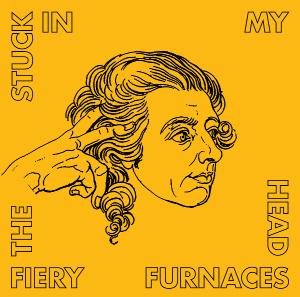
es they were going to be: were they a guitar band this time, or a keyboard band, or something in between (cf. the live album Remember, which collages different performances of the same songs into mad medlies). After achieving almost inexplicable popularity for such an oddball outfit (an album built around recordings of the grandmother of Matthew and Eleanor Friedberger— the band’s sibling core—telling stories is just one example), they took a long pause in 2011, each releasing solo albums, starting families and indulging in other artistic pursuits. A decade later, they reconstituted for shows at Brooklyn Steel and in Chicago and Los Angeles, and then went into the studio to lay down their latest realizations. That session came out last month (self-released streaming and download) and it’s a fantasy best-of. Twenty faves with a keyboard/bass/drum band, Eleanor handling all of the vocals and a perfect title: Stuck in My Head. Their arcane songs, with too many words and long, twisting melodies, managed somehow to be ear candy. The sibling act never really broke up, so there’s always a chance we’ll hear more—maybe a new album by 2034.
Lin Manuel-Mirana, the powerhouse behind Hamilton, and playwright/ songwriter Eisa Davis have reinvented the 1979 NYC gangland movie The Warriors into a concept album (CD, LP and download from Atlantic Records last month) which led me to go back and rewatch the movie for the first time in years. It’s not great but is better than I expected, theatrical in that it seems about as staged as an old Star Trek episode. The album is kind of a fan delight. Like most concept albums, the storyline is far from clear on its own, but it bustles with life. As would be expected, it’s a contemporary and multicultural New York City in their audio staging, with better gender parity, some old school rap, more modern hip-hop, swooning ballads and even some leanings toward heavy metal. The nearly chimeric Ms. Lauryn Hill takes the messiah-like role of Cyrus in
one of the highlights of the 80-minute show, and Busta Rhymes, Cam’ron, Ghostface Killa, Nas and RZA are among the album’s many voices.
There’s also some wonderful reworking in the soundtrack to Joker: Folie à Deux (CD, LP, download from WaterTower/Interscope last month), a movie I quite enjoyed — don’t let the Rotten Tomatoes fool you. Arrangements of such chestnuts as “That’s Life,” “What the World Needs Now Is Love,” and “When You’re Smiling”— customed after-the-fact to Joaquin Phoenix and Lady Gaga’s in-character performances—are subtly haunting. Arnold (The Joker) and Lee (Harley Quinn, aka Harlequin) imagine themselves as show people but their brains are dark places and the orchestrations come with an undertow. Gaga in particular does a stellar job maneuvering between timid voice and brassy, imagined voice. It’s worth seeing if only to hear the soundtrack (and Hildur Guðnadóttir’s score) on a cinema sound system, but also for scoffing rights next time someone tells you it wasn’t the movie they wanted it to be.
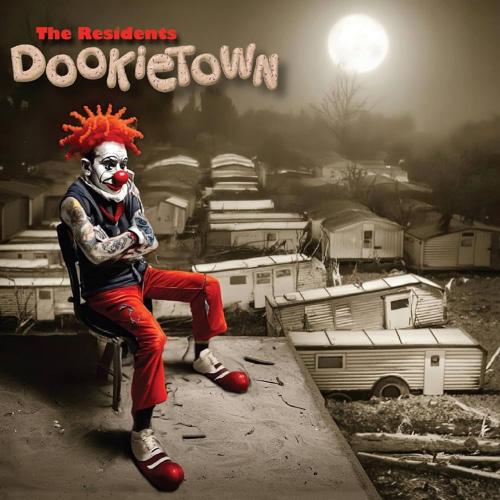
And speaking or wretched clown, The Residents released a set of a half-dozen songs on Nov. 1 (10” EP and download via Cherry Red Records, MVD Audio and New Ralph Too) asking the perennial question, “where do clowns go when they die?” It’s a maddening 24 minutes of psycho-ditties, distorted voices, violence and an incessant laugh track. In other words, classic Residents. And speaking of classic Residents… The mysterious, anonymous troupe has never been bashful about reinventing and rereleasing selections from their 50+ years of making records. It’s a lot to keep track of, with limited returns for all but the diehard, but The Residents Presents Buy or Die! Ralph Records 1972-1982 (triple CD and download out Nov. 4 from Cryptic Corporation) is an essential chunk of history from the fringes of rock. Unable to get record company interest in their early days, the Residents started their own label and
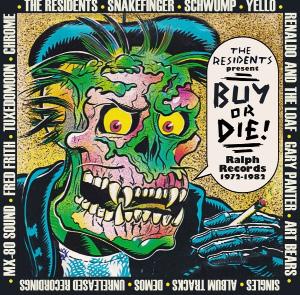
forged distribution channels (primarily through mail order) at a time when such DIY efforts were rare. The weird thing was, they turned out to be pretty good at it, gaining attention, signing other bands and putting out promotional samplers under the banner “BUY OR DIE.” The new set includes those promo tracks and other singles, select album tracks and unreleased material from not just the Residents but Art Bears, Chrome, Fred Frith, MX-80 Sound, Renaldo and the Loaf, Schwump, Snakefinger, Tuxedomoon and Yello, as well as a handful of tracks by comic and graphic artist Gary Panter. It’s a surprisingly diverse chunk of independently produced music long, 63 tracks from before “indie rock” was a genre, and a glimpse into the a world before the Internet made musical outskirts accessible—back when you had to earn your weird.
(continued from page 1)
B.R.- In a previous interview was raised that boomers are “Too old to Matter.” What’s your reaction to that.?
Joe Ford-I think that being a boomer, a person of this generation, there’s a certain productivity that was expected. There was an America that was on the rise. A lot of things were not told to us that we had to find out for ourselves.
In 1968 when we started seeing the fire hoses and the Pettit bridge we began to realize how insulated those of us in the white middle class were, and how tough it was for others. So, our cavalier attitude hadn’t been confronted with defeat. Then I started seeing older guys on the block going off to Vietnam and coming back quite changed. I just missed getting drafted but Vietnam affected all of us. The Millennials have never been exposed to the horrors of war so it’s really easy to talk big and get radicalized. Saying stuff like “Well I’m a Libertarian and the government is spending too much money defending Ukraine. And in the South China Sea, we should reconsider our imperialist tendencies.”
I think some of today’s issues can be summed up in the words of the scientist Neil Degrasse Tyson who says: “ The problem in this world is that too many people know enough to think they’re right, but not enough to know they’re wrong.”
B.R.- Ok…..how’s the coffee here btw? Joe Ford- (taking a sip) A little weak. You can check out JOE FORD’s recording and production work @(South-
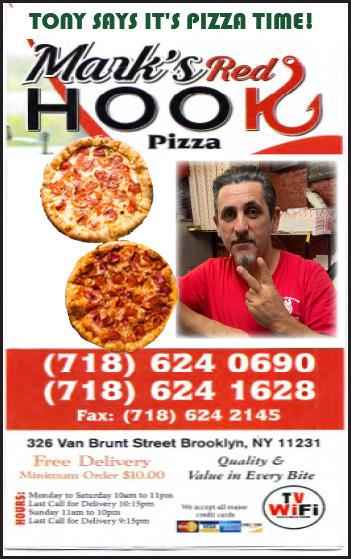



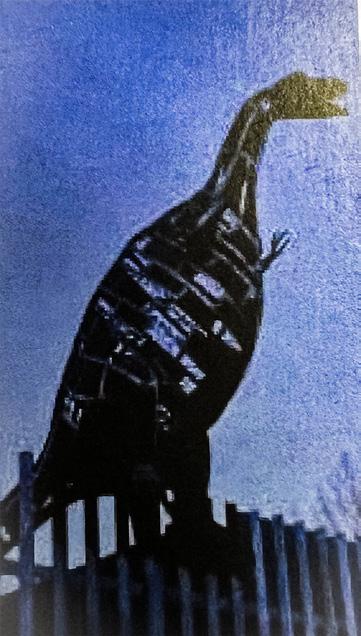

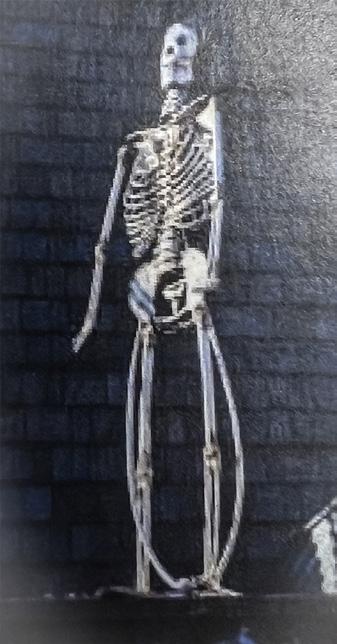
Most
Review of “Countée Cullen’s Harlem Renaissance,” by Kevin
Brown
Review by Michael Quinn
“Yet do I marvel at this curious thing: / To make a poet black, and bid him sing!” – Countée Cullen, “Yet Do I Marvel”
Come Thanksgiving, thoughts naturally turn to family and the communities that shape us. Kevin Brown’s “Countée Cullen’s Harlem Renaissance” is a collection of linked essays that traces Brown’s family history to Harlem’s golden age. The book is a powerful meditation on memory and the ties that bind us. While it isn’t a memoir, Brown skillfully weaves his personal story, photos and historical ephemera into the narrative, creating something unique and compelling.
Bloodlines and bonds
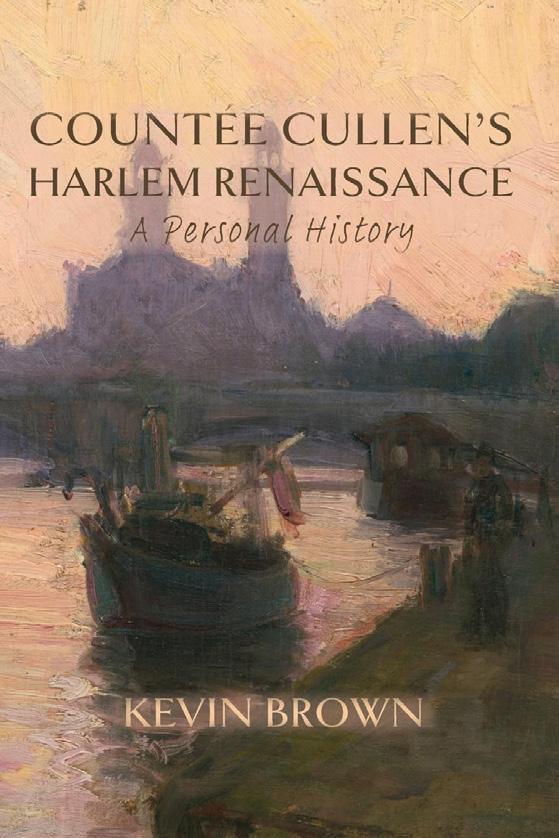
Countée Cullen (1903–1946), a key figure in Harlem’s cultural movement, is best remembered for his lyrical poetry, which captures the joys and struggles of being Black in America. Brown’s analysis draws from a familial connection: his maternal great-grandmother, born Ida Mae Roberson, was Cullen’s second wife and literary executor after his death—14 years before Brown was born. “We aren’t related by blood,” Brown explains, “but we are, in ways I hadn’t even imagined, connected.”
Portrait of the artist as a young man
As a young Californian visiting New York, Brown finds Ida Mae immersed in a world of Black art and culture. The young writer is first awed, then intimidated, by Cullen’s legacy. His insecurities deepen after unsuccessful introductions to writers like Owen Dodson. Feeling inadequate, he acts out, straining his relationship with Ida Mae.
Still, he decides to call New York home for a while. The Harlem he finds in 1985 is a far cry from the artistic paradise he’d imagined—he calls it “a crime scene.” The city’s gritty reality and the challenges of a writing career offer new insights into what Cullen faced. “I simply had no way of imagining Countée as a struggling writer,” Brown reflects, where “the only certainty is constant disruption.” Through Ida Mae, Brown also develops a more nuanced view of the Harlem Renaissance, which fostered connections between artists through the feeling of being part of something bigger that was happening, but also caused them to harbor jealousies and form alliances—just like the dynamics in any big family.
Ida Mae’s commitment to protecting Cullen’s literary legacy, which includes never-ending chores like managing copyrights, allows Brown to gain a deeper understanding of her work. As he learns more about Cullen’s personal life, including his same-sex relationships, he sees her dedication in a new light. Yet their relationship doesn’t improve. All the essays converge around this unresolved tension.
While Ida Mae’s fortunes fall late in life, she continues to command attention like a deposed royal. Though living elsewhere, Brown visits periodically, recognizing when he’s about to be dismissed by the way she would “lower her eyelids, turn her high forehead in the other direction, and with those long fingers that curled backward at the tips (like mine), slowly wave her hand downward, as if closing the trash bin.”
Estranged from Ida Mae at her death and left with unanswered questions, Brown embarks on what he calls “a personal search for a usable past”—the catalyst for this book. In his Proustian search for lost time, Brown retraces the steps that brought Cullen and Ida Mae together. He ultimately comes to admire the audacity of a woman walking out of the security of her first marriage in Depression-era Missouri to embrace the uncertainties of literary life in the big city. He also discovers how larger historical forces like the Great Migration and Civil Rights Movement have shaped the choices everyone in his family has made—lives marked by setbacks but also perseverance.
“Countée Cullen’s Harlem Renaissance” is a triumphant tribute to family legacy and personal resolve. It stands as a reminder of the importance of honoring where we come from and the power of gratitude—for family, for history and for the courage to uncover and make sense of the past. Whether you’re celebrating family or estranged from them this Thanksgiving, Brown’s story reminds us that the search for understanding is always time well spent.
by George Grella
All record albums are an audio snapshot of a slice of time—documents of history, in other words. This has always been magnified in jazz, a music developed in actual conjunction with recording and broadcast technology, where so many musicians through the decades learned to play by listening to, transcribing, and playing along with the records from the musicians they love.
The bulk of this has been a controlled history in that studio albums are staged events, organized around settled ideas and material. There are exceptions, of course, especially the bulk of Miles Davis’ discography (and more on that ahead), records of important free jazz sessions, and live albums.
Davis was one of the most innovative thinkers in jazz on how to use the studio. From this first great quintet, he was constantly working away from the standard recording approach, from playing the material straight through, mistakes and all, as if it were a live club set, to turning the recording process into a complete musique concrète composition on Bitches Brew. For improvisers, there are the unique meetings and irreproducible results, like Jimmy Giuffre’s Free Fall album, and then Life of a Trio sessions with Giuffre, Paul Bley, and Steve Swallow 30+ years later. Duke Ellington at Fargo, 1940 Live is not just one of Duke’s great bands on disc, but the band playing in their original element, which was for dancers—not in the Cotton Club, but not far gone from what that might have been like. For an artist working at the fringe and doing much of his playing without ever being recorded, the live album Nefertiti, the Beautiful One Has Come is a chance to eavesdrop on the young artist in 1962 forming his enduring style.
These albums and others like them capture historically great music and historic, and often rare moments—especially radio broadcast transcriptions of performances meant to be heard in real time, then disappear into memory. It is a record of information that’s a finished history of the music, in that the vast majority of albums are history books but without bibliographies or footnotes that show original sources—which in musical terms would be the sketches of material, rehearsals, and alternate and/ or incomplete/unedited takes that never made to the final album.
Amidst all this, it is as rare as astatine to actually hear the precise moment that history changes. To begin with, music is a process, and there’s just almost no discrete moments that define a change between how things were done before and how they were done after. Moments like the premiere of Beethoven’s Symphony No. 3 on April 7, 1805, or
when the audience first heard the “Tristan” chord in the prelude to Wagner’s Tristan und Isolde, June 10, 1865, or the notorious May 29, 1913 opening night of Le Sacre du printemps stand out as truly revolutionary fulcrums because they came in eras when music was heard live (even predominantly so in 1913), and new music came without preparation.
The recording era might seem to have changed this, except that again recordings are made to be finished. Sometimes insightful home recordings turn up, like Clifford Brown practicing or Charlie Parker playing with colleagues in a period when no regular recordings where being made. There’s a new album out from Verve, Bird in Kansas City, that collects some previously issued tracks along with newly redis-
"Davis was one of the most innovative thinkers in jazz on how to use the studio."
covered recording of Parker working his way through and out of swing. The album has two lushly but densley restored 1941 tracks from Jay McShann and his Orchestra, with no way to pick out Parker from the ensemble. These come at the end, the real gems are at the beginning, with Parker recorded with an unknown bassist and drummer in the home of Phil Baxter (a friend of Bird) in Kansas City, 1951. Already deep into the bebop era, Parker sounds so relaxed that he brings back the swing feel and style that follows via the reissue of a handful of tracks of Parker playing with guitarist Efferge Ware in 1944. These have been out before, notably on the important The Complete “Birth Of The Bebop” CD on Stash. Those tracks came at the end of the Musician’s Union recording ban. Late in November the following year, Parker, Dizzy Gillespie, Miles Davis, Max Roach, Curly Russell, and Sadik Hakim were in the studio, putting down some of the first bebop singles ever recorded and released. This was before the main album era, and the tunes were later collected on Savoy’s The Charlie Parker Story LP. That was released on vinyl in 1956, by then foundations of the jazz canon. The Complete Savoy and Dial Studio Recordings 1944-1948 in 2000 not only recollected that album but issued alternate material from the session, and that’s where you can hear the moment history is made.
The context is on the Verve release, Parker playing “Cherokee” in each
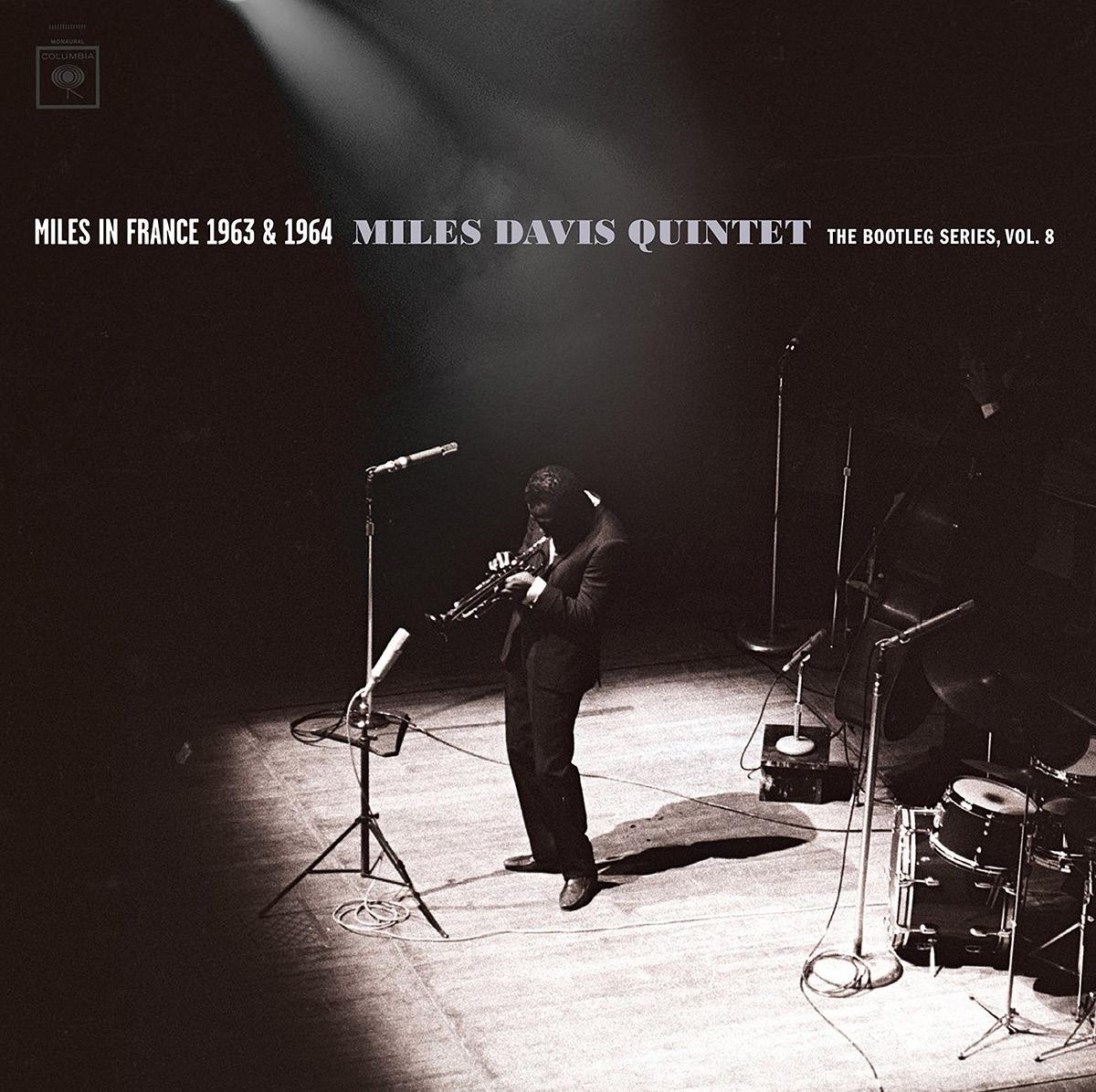
small group recording. This was a big band standard, one of the tunes the beboppers took, dropped the original melody, sped up, and then added their own new motivic ideas on top. “Ko-Ko,” recorded November 26, 1945, is based on that, keeps the harmonies and adds Parker’s bebop ideas. The first take has the band playing the fast bebop intro, then they start playing the “Cherokee” tune. Parker stops playing, whistles, and halts the band. The next, master take, once they get past the intro, they play Bird’s ideas and bebop shoves swing aside. And between those two tracks, you can hear not only history being made, but how it was made, and the exact moment it was made. It’s incredible we have this available.
This month, you can hear the same thing happening almost 20 years later. Sony/Legacy are release Volume 8 in their Miles Davis Bootleg Series of (mostly) live archival recordings. The subtitle to the new set explains it: Miles in France - Miles Davis Quintet 1963/64, concert recordings from one of Miles beloved destinations that span the end of the post-Coltrane quintet transitional period—George Coleman is the tenor on the 1963 dates, July 26-28—into the first appearances of the second great quintet with Wayne Shorter, who plays on the October 1, 1964 concert (Shorter had joined the group maybe two weeks prior).
The October concert is another incredible moment when history changed, captured on audio. The late 1950s on, Miles was developing his modal concept into a fruitful path for modern jazz. But always looking for new directions and refining every idea that
crossed his path or came into his mind, he shed his previous group and hired the young musicians Shorter, Herbie Hancock, Ron Carter, and the prodigious virtuoso Tony Williams (who is still just 17 at the 1963 performances). Miles wanted musicians who would surprise him and show him new things, and famously felt that they were actually leaving him (of all people!) behind in the early stages of this band. By the time of the important Plugged Nickel live recordings, Christmastime 1964, Miles was all caught up and again leading the way, but he had to get there from some point prior. And, it turns out that point was October 1, 1964. That night, Miles opened the second set with one of his favorites, “My Funny Valentine.” He plays it with all the intelligence and care a listener expects from him, and tosses in a few familiar musical devices, like a quick, wobbling rise-and-fall hiccup and a fast, upward rip. He finishes his solo, and then Shorter steps up to the mic. And all of a sudden this is an entirely different group, playing an entirely different music, something allusively and subtly exploring the outer boundaries of song form without abandoning it. Shorter plays a long tone and takes a long pause, Hancock tosses in a brief, dissonant almostmodulation, a specific musical idea that he never plays on any other recorded instance of this group. All of a sudden, Miles sounds a little old fashioned, all of a sudden, a new music appears. In a few seconds, the direction of decades of music that came after was decided. It’s breathtaking.
